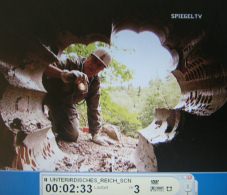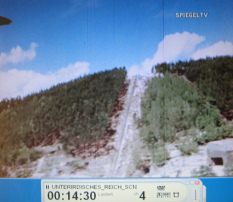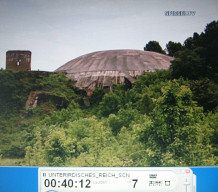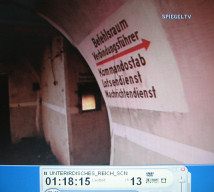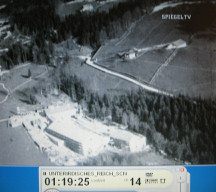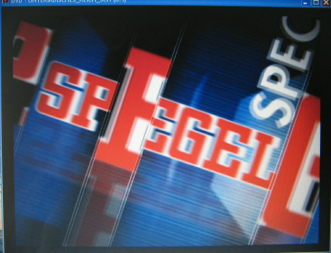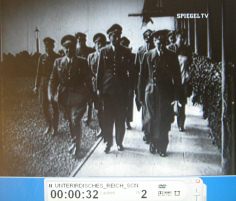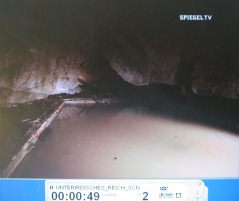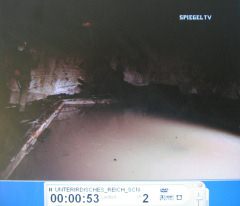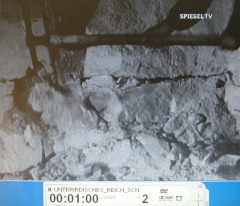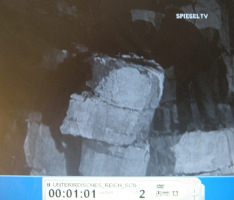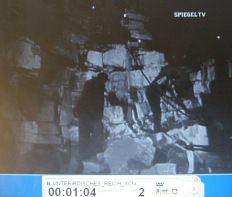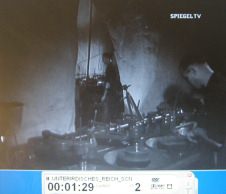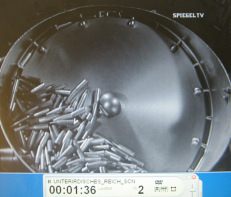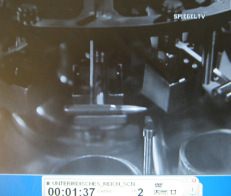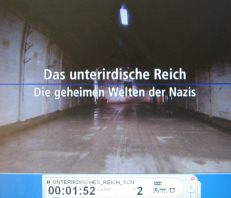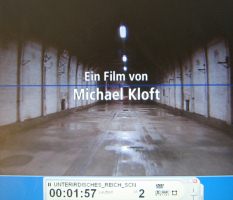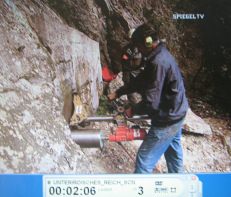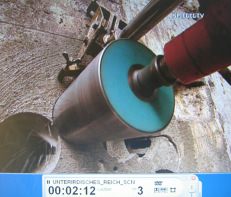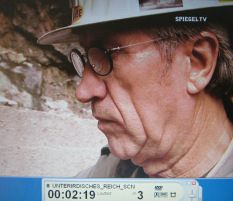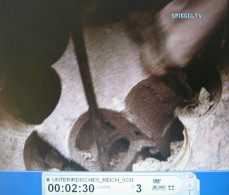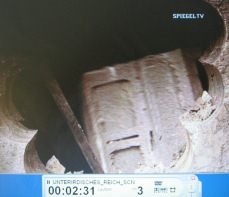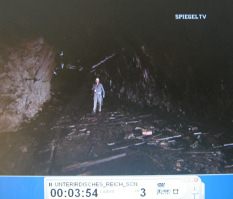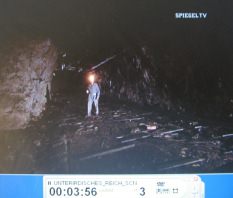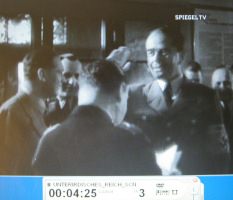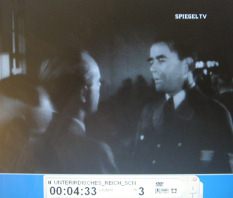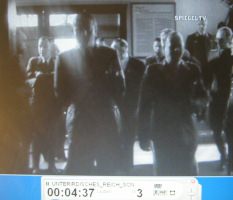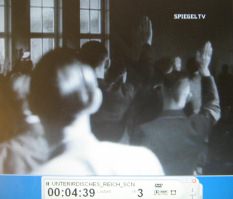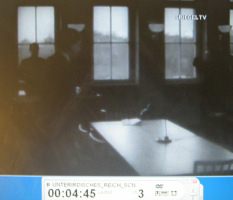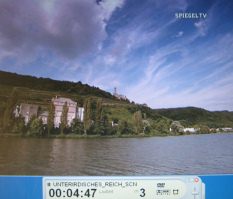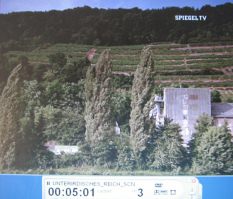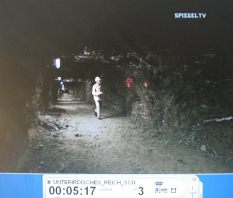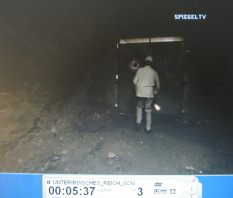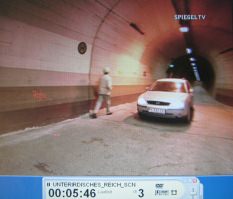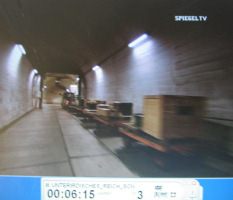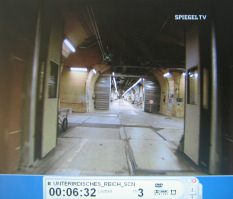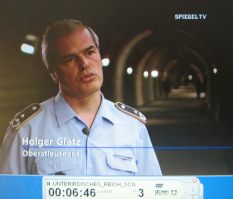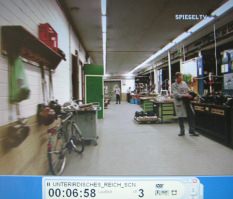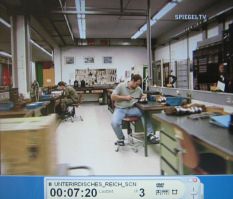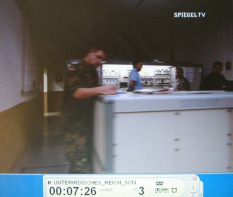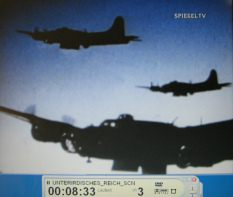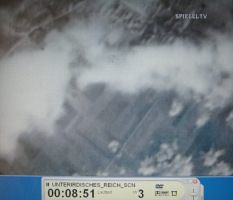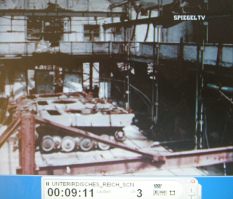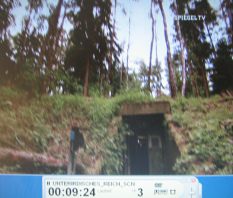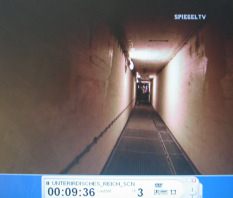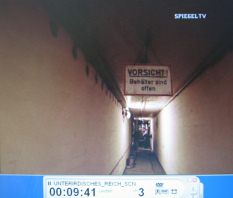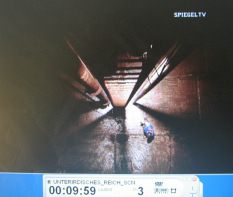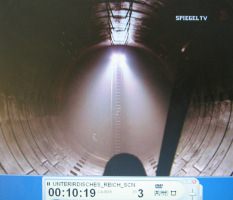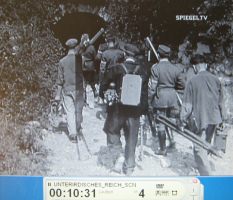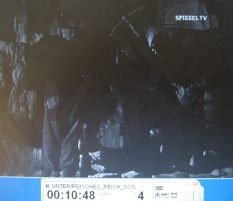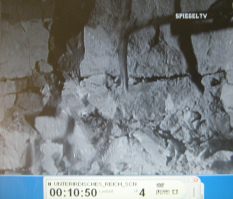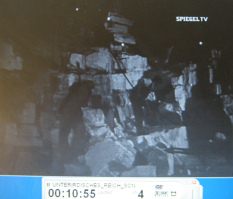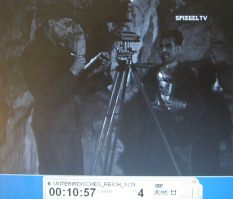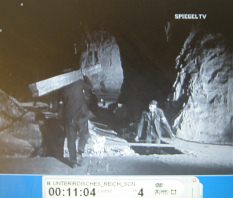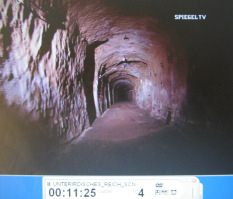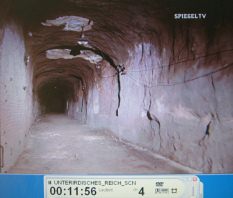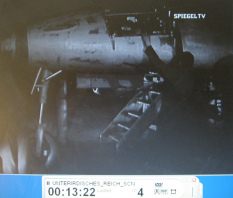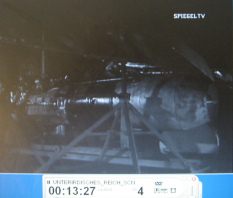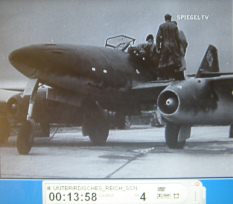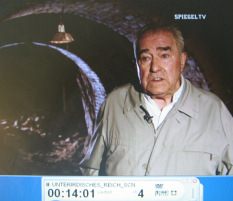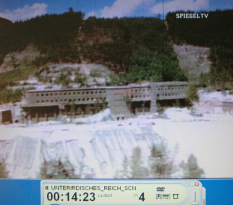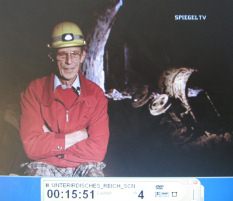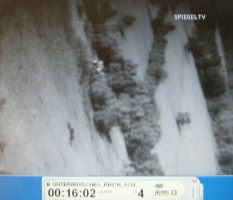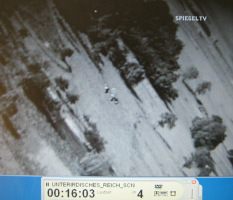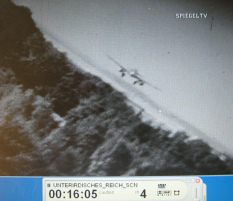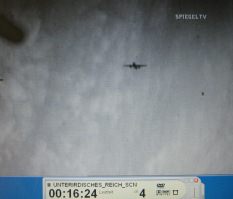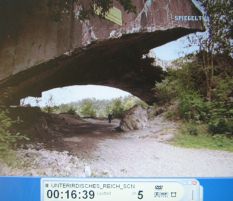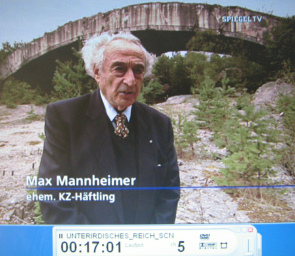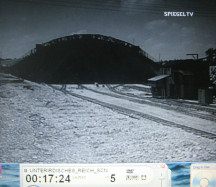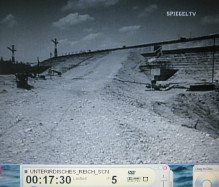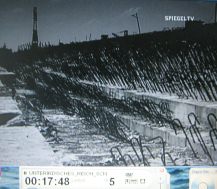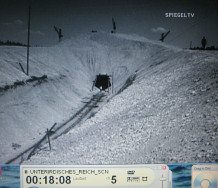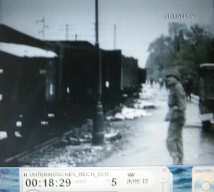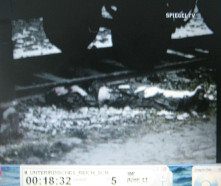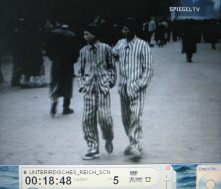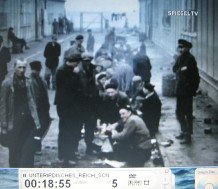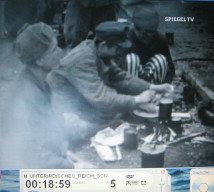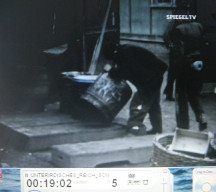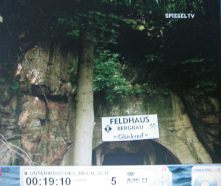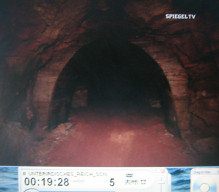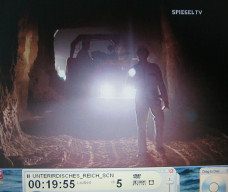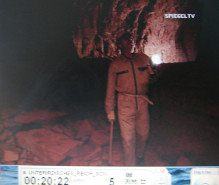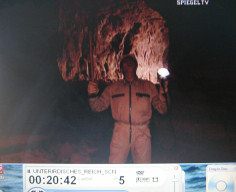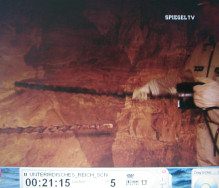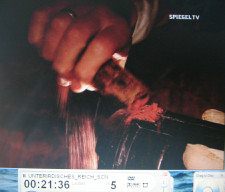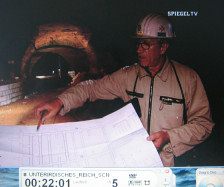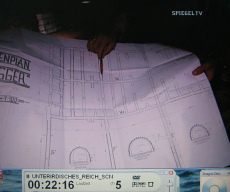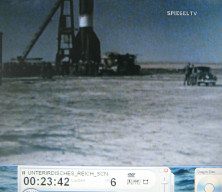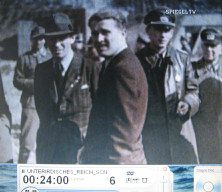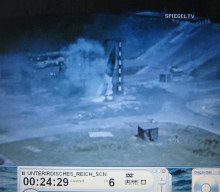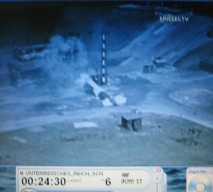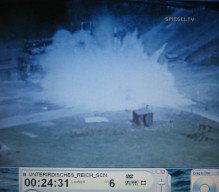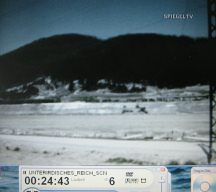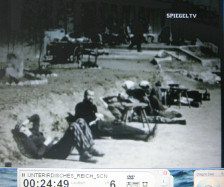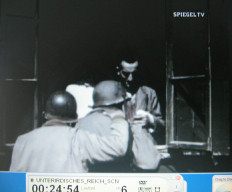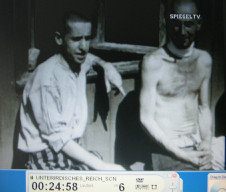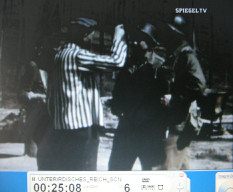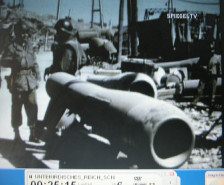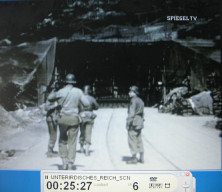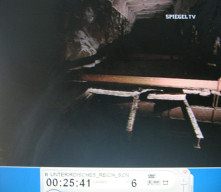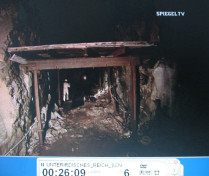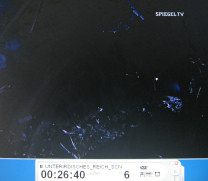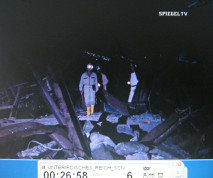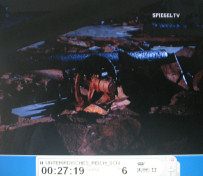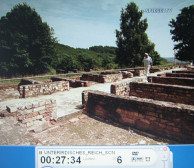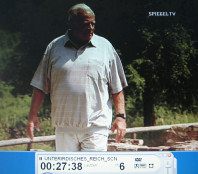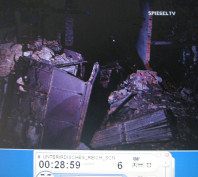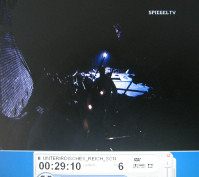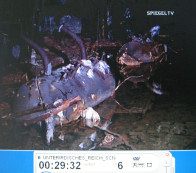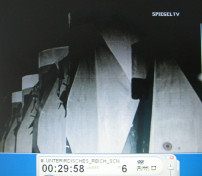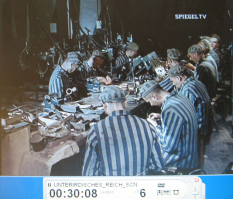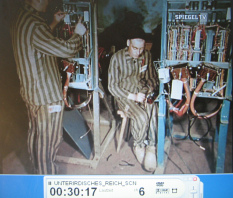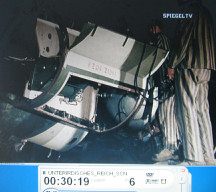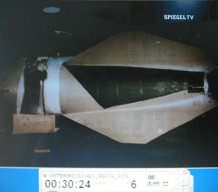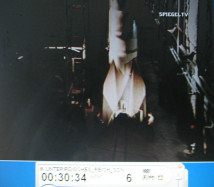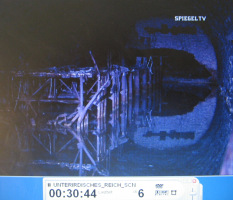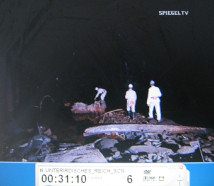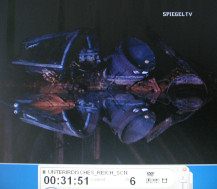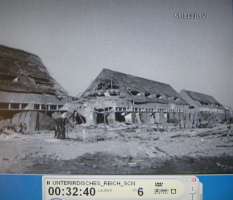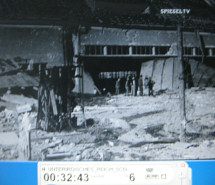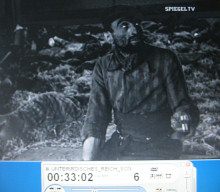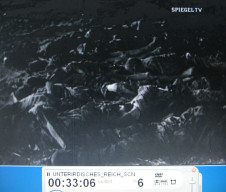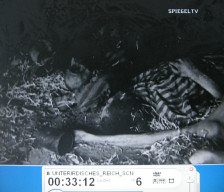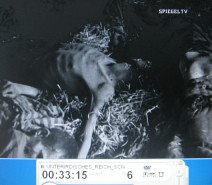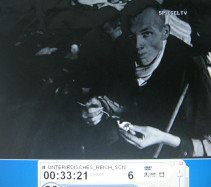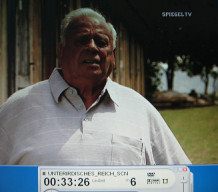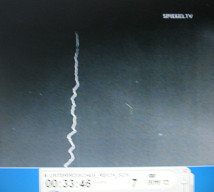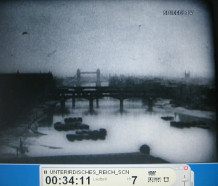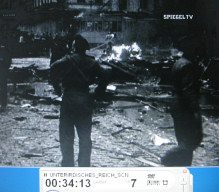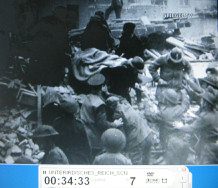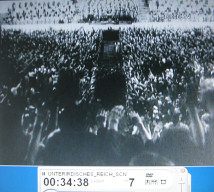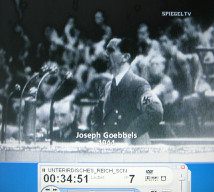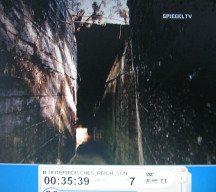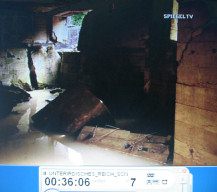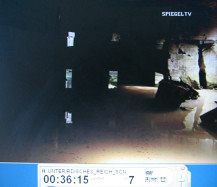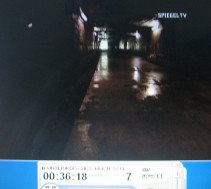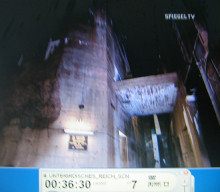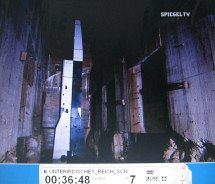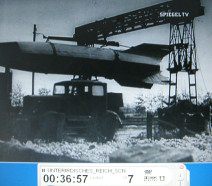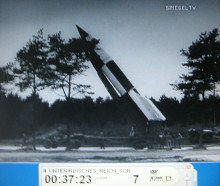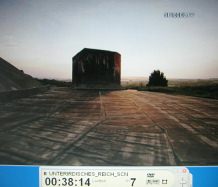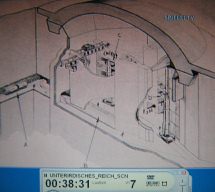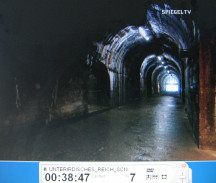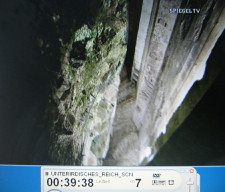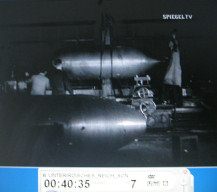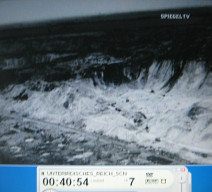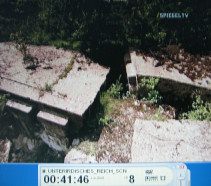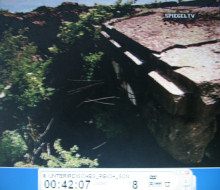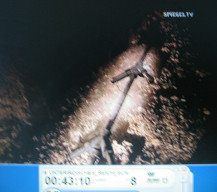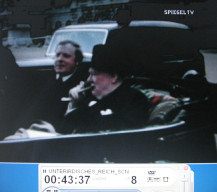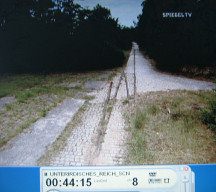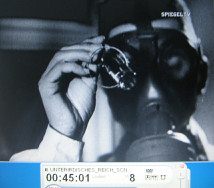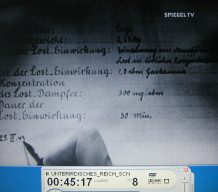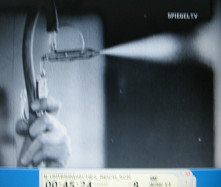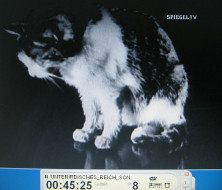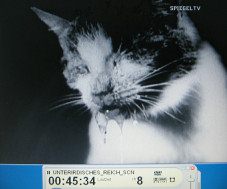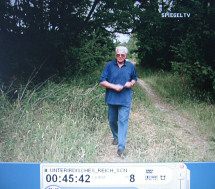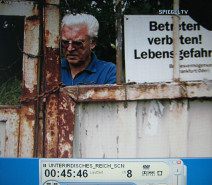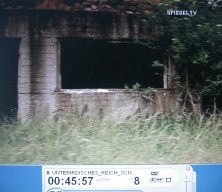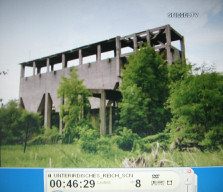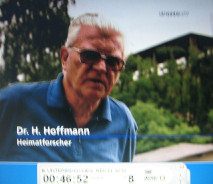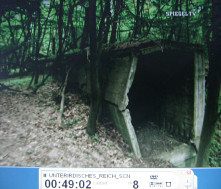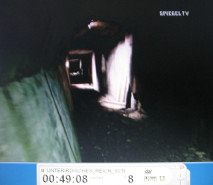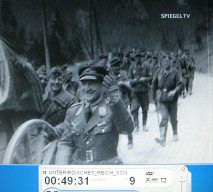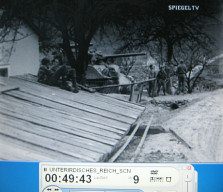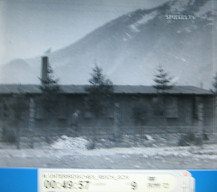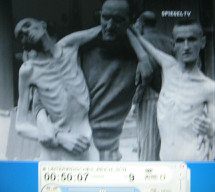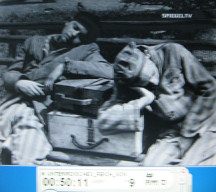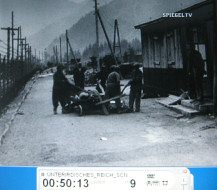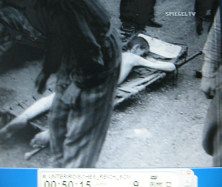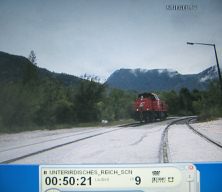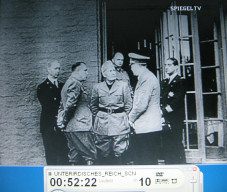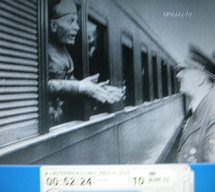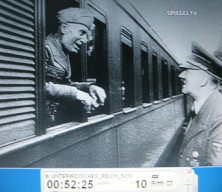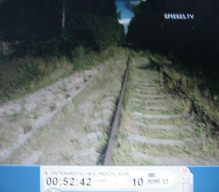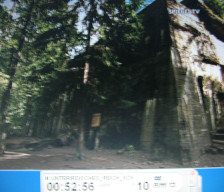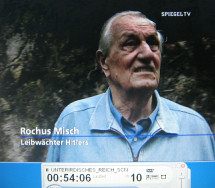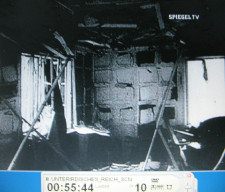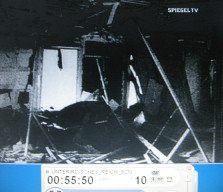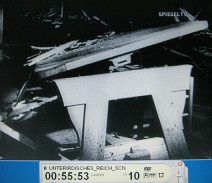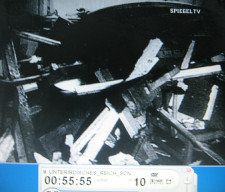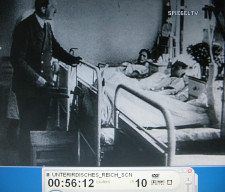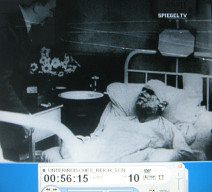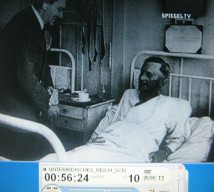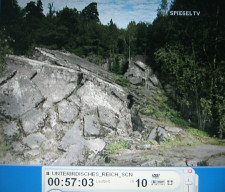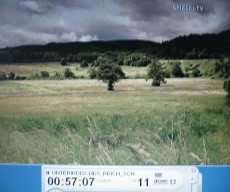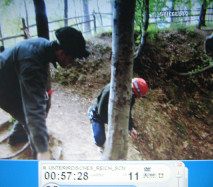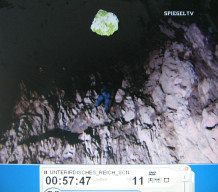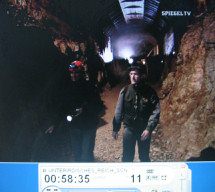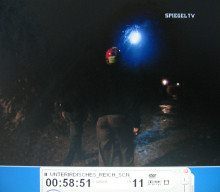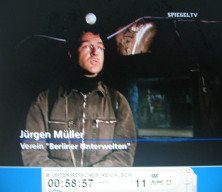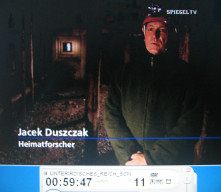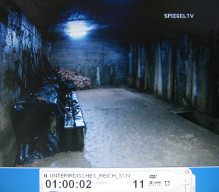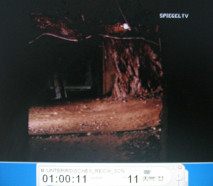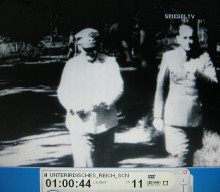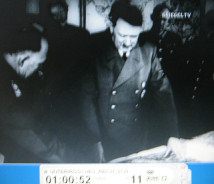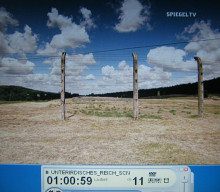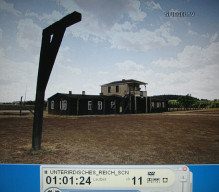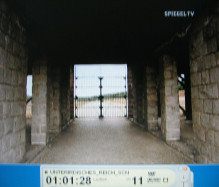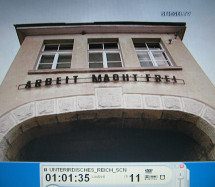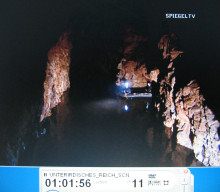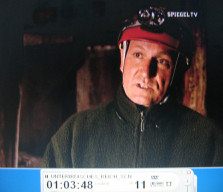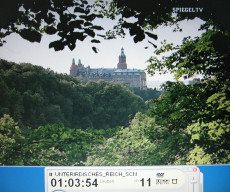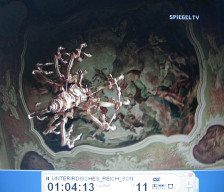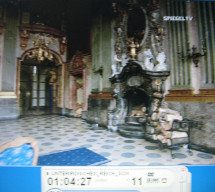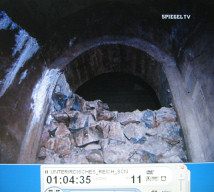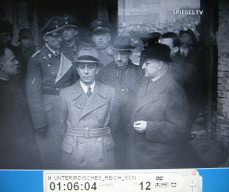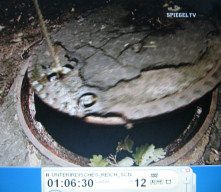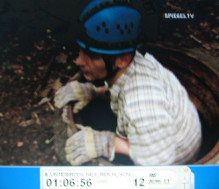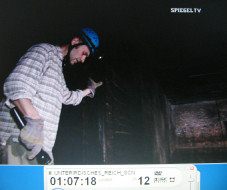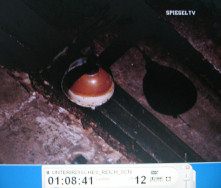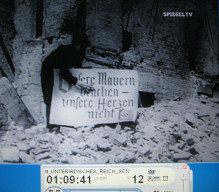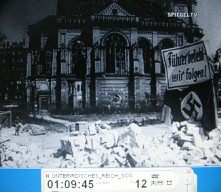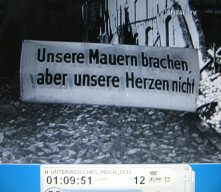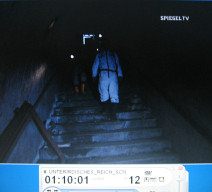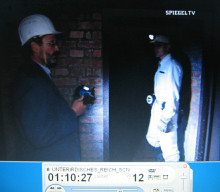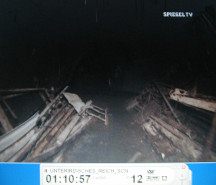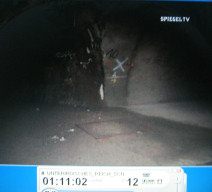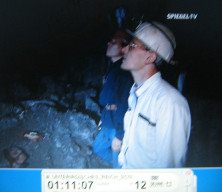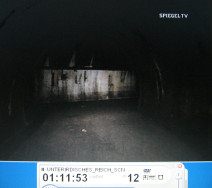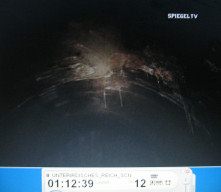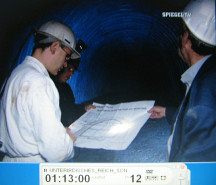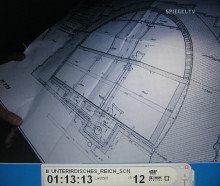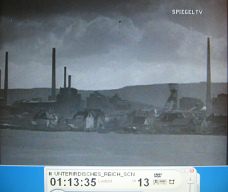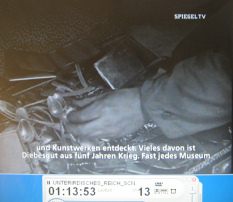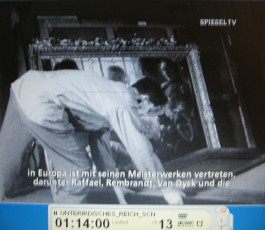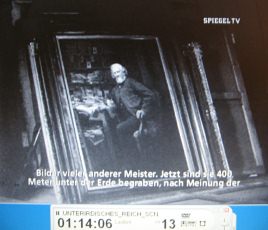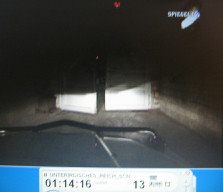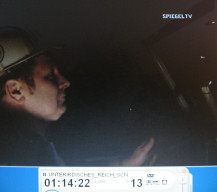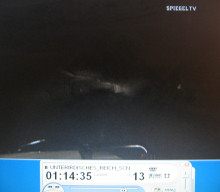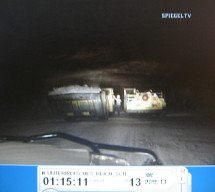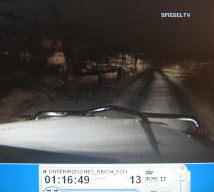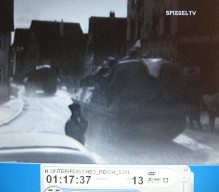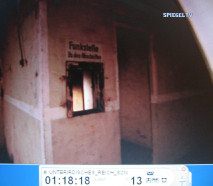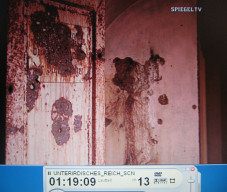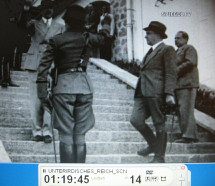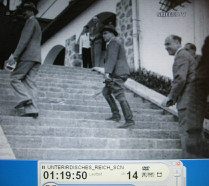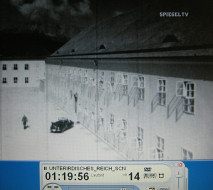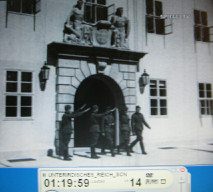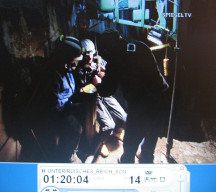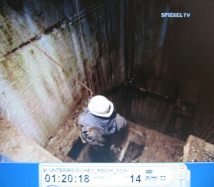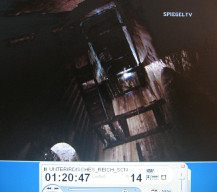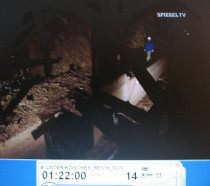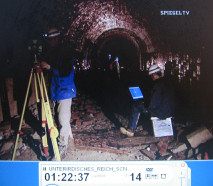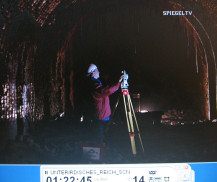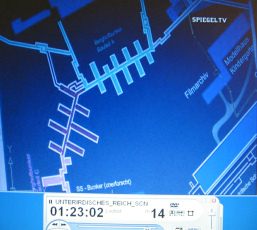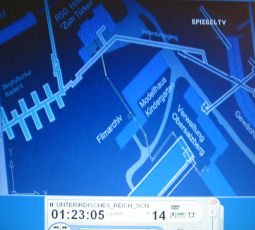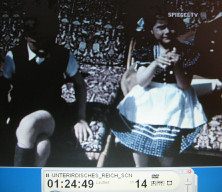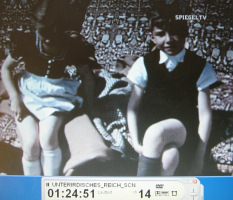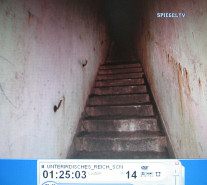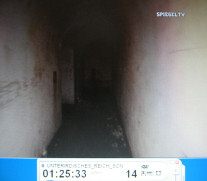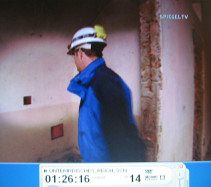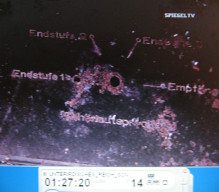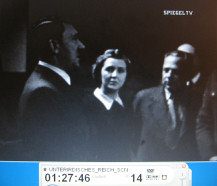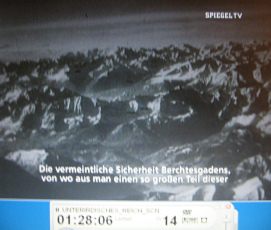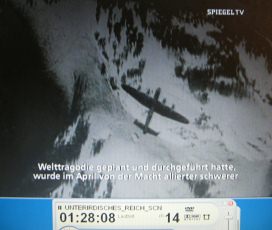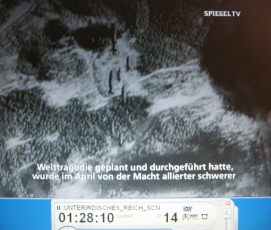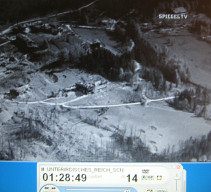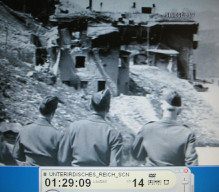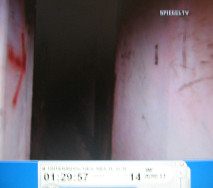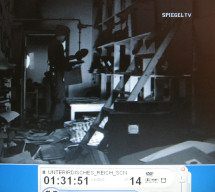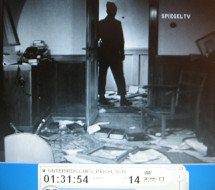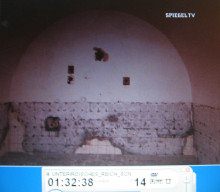|
|
|



D
Third Reich: Tunnel constructioning in the Third Reich
The Underground Reich. The Secret Worlds of the Nazis
[Persecution of the Jews and Holocaust with mass death in NS tunnel systems and bunker systems]
by Michael Palomino (2006 / 2015) - translation in 2007. The number of the victims is not fixed until today.
http://www.hist-chron.com/judentum-aktenlage/hol/bunkerbau-SpiegelTV2003_the-underground-reich-ENGL.htm
1. Introduction -- 2. Underground airplane production plant in Oberammergau (Bavaria): pseudonym "Neustadt" ("New Town") - caretaker Heinz Rabe -- 3. The dimension of the tunnel constructioning: 340 building sites, 400 pseudonyms, 800 projects -- 4. Underground jet fighter production plant at Neckarzimmern on Neckar River -- 5. The dimensions of the tunnel constructioning: 80% of the warfare industry shall be brought into bunkers -- 6. Underground fuel deposits near Bremen: working until today -- 7. The dimensions of the tunnel constructioning: "High pressure" - forced labor in Kahla: "Lachs" ("Salmon") -- 8. Underground airplane production plant: Walpersberg near Kahla, pseudonym "Lachs" ("Salmon") -- 9. Dimensions of the tunnel constructioning: 100,000s of detainees brought back to the Reich up to the last day -- 10. Underground airplane production plant: Muehldorf on Inn River: approx. 2,000 deaths -- 11. Dimensions of the tunnel constructioning: last transport into CCs in April / May 1945, e.g. to Dachau -- 12. Underground tunnel system in the dogger work near Hersbruck for BMW motor production, pseudonym: "Esche 1" ("Ash Tree 1") - approx. 3,500 deaths -- 13. Underground rocket production after the bombing of Peenemünde: for V2 (A4): Nordhausen: Kohnstein: 10,000s of deaths -- 14. Underground rocket silos (rocket launching pads) for V2 in Watten --15. Underground rocket silos (rocket launching pads) for V2 in Viserne: "La coupole" - British "Tallboy" bombs -- 16. Bunker constructioning: Underground rocket silos for V3 at Mimoyecques -- 17. Falkenhagen near Berlin: Chemical plant with the aim of sarin production -- 18. Underground rocket production plant for intercontinental rocket A9: Ebensee near Salzburg, pseudonym: "Zement" ("Cement") -- 19. The concrete encased and then blasted Wolfsschanze - a table is saving Hitler's life -- 20. Bunker constructioning in the Eulengebirge (Owl Mountains) for a new leader's headquarter: example: Gluszyca: "Säuferhöhen" ("heights of drunks") -- 21. Bunker constructioning in the Eulengebirge (Owl Mountains) for a new leader's headquarter: example: Wolfsberg (Wolf Mountain) -- 22. Owl Mountains: Suspicion that there are more tunnel systems -- 23. Bunker constructioning in the Eulengebirge (Owl Mountains) for a new leader's headquarter: example: "Fuerstenstein Castle" ("Stone of Prince Castle") -- 24. The German population does not know anything about the tunnel systems - is living in ruins itself -- 25. "Axes of coordinates" and motorway tunnel in Berlin - use of the bunker as a fabrication hall -- 26. Bunker town under Dortmund -- 27. Kaiseroda / Merkers (Thuringia): loot was placed in the bunker systems - the secret evacuation by the allies -- 28. Bunker plant of Stuttgart: Mount Killesberg -- 29. Bunker system at Mount Obersalzberg: "Berghof": almost 6km of bunker systems completed -- 29.1. Bunker at Mount Obersalzberg: the Bormann family -- 29.2. Bunker at Mount Obersalzberg: bunker for Eva Braun -- 29.3. Bunker at Mount Obersalzberg: preparation for Hitler's last fight -- 29.4. Bunker at Mount Obersalzberg: Eva Braun's rooms
| Teilen / share: |
Facebook |
|
Twitter
|
|
|
|
from: Spiegel TV history: Film "Das unterirdische Reich" from Michael Kloft.
Authors: Michael Kloft, Michael Foedrowitz. Cooperation: Lars. T. Andersen, Frank Gensthaler; speaker: Peter Buchholz, Kay Siering, Robert Wortmann; sound mixing: Jens Burfeind; u.a. ; Spiegel TV 2003 (Information about staff members gives the press office of Spiegel TV, tel. 0049-(0)40-30 10 80); delivery of the film on DVD (ISBN no.: 3-937163-35-2) at Polarfilm (tel. 0049-(0)2542-95 13 13), or in the internet http://www.polarfilm.de
Content: Chapters
1. Introduction
2. Underground airplane production plant in Oberammergau (Bavaria): pseudonym "Neustadt" ("New Town") - caretaker Heinz Rabe
3. The dimension of the tunnel constructioning: 340 building sites, 400 pseudonyms, 800 projects
4. Underground jet fighter production plant at Neckarzimmern on Neckar River
5. The dimensions of the tunnel constructioning: 80% of the warfare industry shall be brought into bunkers
6. Underground fuel deposits near Bremen: working until today
7. The dimensions of the tunnel constructioning: "High pressure" - forced labor in Kahla: "Lachs" ("Salmon")
8. Underground airplane production plant: Walpersberg near Kahla, pseudonym "Lachs" ("Salmon")
9. Dimensions of the tunnel constructioning: 100,000s of detainees brought back to the Reich up to the last day
10. Underground airplane production plant: Muehldorf on Inn River: approx. 2,000 deaths
11. Dimensions of the tunnel constructioning: last transport into CCs in April / May 1945, e.g. to Dachau
12. Underground tunnel system in the dogger work near Hersbruck for BMW motor production, pseudonym: "Esche 1" ("Ash Tree 1") - approx. 3,500 deaths
13. Underground rocket production after the bombing of Peenemünde: for V2 (A4): Nordhausen: Kohnstein: 10,000s of deaths
14. Underground rocket silos (rocket launching pads) for V2 in Watten
15. Underground rocket silos (rocket launching pads) for V2 in Viserne: "La coupole" - British "Tallboy" bombs
16. Bunker constructioning: Underground rocket silos for V3 at Mimoyecques
17. Falkenhagen near Berlin: Chemical plant with the aim of sarin production
18. Underground rocket production plant for intercontinental rocket A9: Ebensee near Salzburg, pseudonym: "Zement" ("Cement")
19. The concrete encased and then blasted Wolfsschanze - a table is saving Hitler's life
20. Bunker constructioning in the Eulengebirge (Owl Mountains) for a new leader's headquarter: example: Gluszyca: "Säuferhöhen" ("heights of drunks")
21. Bunker constructioning in the Eulengebirge (Owl Mountains) for a new leader's headquarter: example: Wolfsberg (Wolf Mountain)
22. Owl Mountains: Suspicion that there are more tunnel systems
23. Bunker constructioning in the Eulengebirge (Owl Mountains) for a new leader's headquarter: example: "Fuerstenstein Castle" ("Stone of Prince Castle")
24. The German population does not know anything about the tunnel systems - is living in ruins itself
25. "Axes of coordinates" and motorway tunnel in Berlin - use of the bunker as a fabrication hall
26. Bunker town under Dortmund
27. Kaiseroda / Merkers (Thuringia): loot was placed in the bunker systems - the secret evacuation by the allies
28. Bunker plant of Stuttgart: Mount Killesberg
29. Bunker system at Mount Obersalzberg: "Berghof": almost 6km of bunker systems completed
29.1. Bunker at Mount Obersalzberg: the Bormann family
29.2. Bunker at Mount Obersalzberg: bunker for Eva Braun
29.3. Bunker at Mount Obersalzberg: preparation for Hitler's last fight
29.4. Bunker at Mount Obersalzberg: Eva Braun's rooms
1.
Introduction
Das unterirdische Reich (The Underground Reich), start of the film
Das unterirdische Reich (The Underground Reich), start of the film with the text "Spiegel special"
Speaker:
It was one of the most giant engineering projects of human history: bomb safe production plants for the Third Reich.
[Photo: Rocket remnants in a flooded tunnel].
Introduction: Tunnel system
Introduction: Remnant of a V2 rocket at Kohnstein in a flooded tunnel.
So called "wonder weapons" should bring death and destruction to the enemies, huge underground factories should deliver supplies for the Wehrmacht.
Introduction: Tunnel system at Oberammergau with electric car.
100s of millions of Reichsmarks were spent to undercut complete mountains. Production plants for strategic armaments should be installed in long tunnel systems for miles.
[Photos: a tunnel caretaker in a tunnel system with the sight to a water basin].
Introduction: water basin in a tunnel system
Water basin in a tunnel system with tunnel caretaker Heinz Rabe (left)100,000s of slave workers had to compass the work for the Nazis. How many lost their lives is not sure. Up to the last day of the war there was feverish work in the tunnels [Photos: Tunnel workers with pit and shovel moving some stones in a tunnel].
Introduction: a pickax on some rubble 01
Introduction: a pickax on some rubble 02
Introduction: forced laborer moving rubble 01
Introduction: forced laborer moving rubble 02But how near were the Nazis at the triumph of the crazy project? What would have passed when the underground armament production would have had performed on full speed? Had Hitler's extermination war required some millions more death victims?
[Photos: tunnels in preparation for armament production, at the end cartridges are coming out from a concrete-lined hall].
And now comes the title of the film:
"The Underground Reich. The Secret Worlds of the Nazis. A Film by Michael Kloft."
(original German: "Das unterirdische Reich - Die geheimen Welten der Nazis. Ein Film von Michael Kloft.")(It seems strange that the co-producer, tunnel system historian Michael Foedrowitz, is not indicated here).
2. Underground airplane production plant in Oberammergau (Bavaria): pseudonym "Neustadt" ("New Town") - caretaker Heinz Rabe
Speaker:
A slope near the Bavarian community of Oberammergau.
[Photo: a slope]
Hidden from the view of curious people there a mysterious tunnel system can be found being built by the Nazis [respectively by the detainees]. The only entrance is closed by a concrete plombage. Only a statal mining expert can open it because in a rhythm of some years he has to make a regular inspection.
[Photos: a concrete wall at the entrance is opened with tophat drillings in a circle order so at the end a big piece of concrete is falling down leaving a big hole].
The drilled hole is pushed open 04
Oberammergau: the view by the hole looking outMr. Heinz Rabe is responsible for about 20 underground tunnel systems in South and East Germany guarding safety of the 60 years old systems.
[Photo: Heinz Rabe entering the tunnel]
Oberammergau: tunnel caretaker Heinz Rabe walking in the tunnel
After the end of the war the Americans had searched all, also in Oberammergau.
[Better: They stole all and have used it for their own armament development].
Since then the tunnels are empty. The wainscots are rotten. At any moment stones can fall from the ceilings.
Tunnel caretaker Heinz Rabe in the tunnel, seen from the back
Oberammergau: tunnel with rotting wooden casing
Oberammergau: Tunnel caretaker Heinz Rabe seen from the backHeinz Rabe, tunnel caretaker in South and Eeast Germany:
Oberammergau: tunnel caretaker and mining expert Heinz Rabe is telling.
"During the war the plant's owner was Messerschmitt AG. It was a bomb safe production and development plant for aircraft constructioning. According to the plans there were 3 or 4 entrances to the plant. We just opened one of them, the other ones had been closed by blasts at the end of the war. And there are two parallel tunnels of a length of about 80, 90 m which are connected by crossways serving as a bomb save production plant."
[Photo: Former production hall in the mountain; tunnel in bare brickwork].
Oberammergau: tunnel caretaker Heinz-Rabe in the tunnel
Oberammergau: Tunnel caretaker Heinz-Rabe in the tunnel with pocket lamp and mining lamp
3. The dimension of the tunnel constructioning: 340 building sites, 400 pseudonyms, 800 projects
The conference making the Hitler salute when the Nazi leadership came in
"Conference" of Hitler's leadership: the speaker comes
The speaker of the Nazi leadership is taking a seat.
4. Underground jet fighter production plant at Neckarzimmern on Neckar River
The iron door is leading to an underground town.
[Photos: concrete-lined, white painted tunnels with tarred lanes].
Holger Glatz, Oberammergau: [talking about the situation from 1939 to 1943, and since 1957]:
Neckarzimmern: lieutenant colonel Holger Glatz is telling:
"During Second World War there were two production plants installed here: one was for ammunition packaging materials for an ammunition factory not far from here, and second was the ball bearing production from a factory which had been at Schweinfurt first. Since 1957 the tunnel system was enlarged within the situation of the Cold War. In case of a possible confrontation such constructions were wanted which were e.g. also safe against atomic bombs, for deposits of parts of high value and for repair works, also under heavy conditions of a performed war."
5. The dimensions of the tunnel constructioning: 80% of warfare industry shall be installed in these bunkers
Speaker:
Above all the ball bearing factories at Schweinfurt were the target of the allied bomber squadrons. Despite of heavy losses the Americans could raze the factories to the ground. But the aim stopping any supply of Hitler's Wehrmacht was not achieved first.
[Photos: allied bombings of Schweinfurt].
Up to 80 percent of the strategic key industries should be brought underground. Aside the ball bearing factories these were the production plants for airplane motors, fuel deposits as well, and the secret rocket program of the SS. Only about 20% was put into operation at the end.
[Photos: damaged house front, burnt motor station, burnt fuel deposit station, burnt tank station].
6. Underground fuel deposits near Bremen: it's working until today
Speaker:
Some facilities were rated as "decisive for the outcome of the war" and had an especially good camouflage withdrawing them from the views of the allied spy planes. So, already in the mids of the 1930s the fuel deposits of Nazi Germany were brought underground. Near Bremen there is such an underground fuel deposit which is working until today, over 60 years later.The state's owned facilities have to be controlled and cleaned periodically. Only trained staff is allowed to go down into the tanks. The huge tanks can contain 4,000 m3 of fuel and are built of 12mm thick ship steel, being covered by a 1m thick concrete ceiling. All in all there are 80 tanks.
Fuel deposit near Bremen 07: descent 01
Fuel deposit near Bremen 08: descent 02
Fuel deposit near Bremen 09: the inner of a tank, total view
7. The dimensions of the tunnel constructioning: "High pressure" - forced labor in Kahla: "Lachs"
Speaker:
In all parts of the Third Reich the construction works underground were pushed on by high pressure.
The NS propaganda film of 1944 says:
"The aim of the enemies to smash the German armament by massive bombing has failed. Strategic production plants were put underground in time and with Teutonic thoroughness."
[In the propaganda film are missing
-- the scaled-down detainees with their illnesses and the deads
-- torture by the SS guards
-- the blasting operations in the tunnels].
8. Underground airplane production plant: Walpersberg near Kahla, pseudonym "Lachs" ("Salmon")
Above all foreign forced laborers had to carry out the filthy job under inhuman circumstances.
Paul Baert, former Belgian detainee (translation):
Walpersberg near Kahla 02, Paul Baert is telling giving his testimony
<The first day we were classified. A German officer made a speech and told us: "You will work until you will fall down to death." In the tunnels 3 persons had to drill holes with a drilling machine, other 3 were shoveling, and one brought the filled wagon out.
From a structure there were drilled holes of 2 1/2 to 3 m of depth into the ceiling and filled with dynamite. Then all was exploding and at once after this we had to go on working and shoveling. We could not see us because of the dust and the gases. But there was no mercy, we had to go on.>
Herbert Roemer, former detainee in Walpersberg near Kahla:
Walpersberg near Kahla 05, Herbert Roemer is telling giving his testimony
"The technical concept was rationally elaborated for sure, and with respect to the air dominance of the allies over Germany it was substantial. The methods were of a sheer madness, of course. It could be foreseen that the war machine which was kept always under fire was reaching it's brink, which whould be the end of the Third Reich. And this was happening under inhumanities, as a normal thinking human being with a normal feeling one cannot understand this any more."
[Photos: tunnel labyrinth in bare brickwork]
NS propaganda film 1944:
"The German leadership announced: German sky has to be liberated."
[Photos: Jet fighter]
Walpersberg near Kahla 06: jet fighter ME262 production, sight from the side
Walpersberg near Kahla 07: jet fighter ME262 production, frontal viewThe film says:
"Our inventors and constructors will withstand and counterattack the masses of enemy terror bombers, they will unconditionally win in the defense and in the attack." - [photo: Engine]
Walpersberg near Kahla 08: a jet fighter ME262 is composed
Walpersberg near Kahla 09: the engine of a jet fighter ME262
Walpersberg near Kahla 10: a mechanic working at a jet fighter ME262[Supplement: Hitler ordered first not to use the jet fighter he had already in 1939 because of possible brain damage for the pilots.
Then Hitler ordered that this jet fighter should be reconstructed into a jet bomber. This costed 1 1/2 years development time and at the end Third Reich lost the war instead of having the jef fighter.
In: Nicolaus von Below: Als Hitlers Adjutant [As Hitler's Adjutant] 1937-1945, Mainz 1980, S./p.355
Well, Hitler had his brain damage (Parkinson) becoming a second Napoleon also without having performed a flight in the jet fighter. Hitler was under mind control of Zionist Rothschild family since 1913 and he was manipulated to lead Germany into the ruins.
In: Hitler Was A British Agent]
Speaker:
One of the most secret new developments of the air force was built in Kahla: the jet fighter [jet bomber] Me-262. The first plane was ready to start in mid of February 1945. [Photo: Airfield with jet fighters]
Walpersberg near Kahla 11: jet fighters ME262 on an airfield
Walpersberg near Kahla 12: jet fighter ME262 is rolling
Walpersberg near Kahla 13: people on a wing of a jet fighter ME262Paul Baert, Belgian detainee at Walpersberg near Kahla (translation):
Walpersberg near Kahla 14: Paul Baert telling, testimony
"The airplane was looking like a fish. It was constructed very modern, very slim and as it seemed it was very fast. We had heard rumors that 1,200 jet fighters should be constructed per month. We just could not believe this. But it was performed under our eyes. We were very afraid of it because it was clear for us: When the war was going on we would not survive."
The not completed tunnels were leading to the real core of the plant: there were 4 huge underground halls where the work on 27,000 m2 should be performed.
Heinz Rabe, tunnel caretaker in South and East Germany:
"We are here in one of the big halls which were foreseen for the final production of the jet airplanes, the Me-262. Here the airplane could be composed completely and then it was torn through the big tunnels out and was torn up the hill by the freight elevator, and then it could start."
Walpersberg near Kahla 19: the other end of the hall
Walpersberg near Kahla 20: tunnel caretaker Heinz Rabe is tellingSpeaker:
On the totally hollowed hill the Germans had even built a runway. The serial production of the jet fighters was only a question of time. But only few were starting yet. [Photo: the back of the mountain with a runway]
Walpersberg near Kahla 21: the runway on the ridge of the mountain 01
Walpersberg near Kahla 22: the runway on the ridge of the mountain 02Herbert Roemer, former detainee at Walpersberg near Kahla:
Walpersberg near Kahla 23: Herbert Roemer is telling his testimony:
"I can remember two starts of the Me-262 yet. We were busy with open air working at a place where we could see what was happening on the mountain. We all looked up and some were even pointing to the horizon. And then we saw a thing which was flying really fast. And one could really - well - to classify this as a wonder weapon category."
[Hitler's air defense under Himmler wanted to defend Germany with Me-262 fighters since 1942, but Hitler did not want it. There are heavy indications that Hitler had Parkinson respectively was under mind control of London Zionist family of Rothschild for leading Germany back to Stone Age].
9. Dimensions of the tunnel constructioning: 100,000s detainees brought back to the Reich up to the last day
[The forced detainees had been brought to Eastern Europe from 1940 to 1942. Now in 1943 all left detainees had to be brought back to the Reich for underground tunnel constructioning].
Speaker:
The Nazi leadership had big hopes for the much conjured "wonder weapon". But at the end the ultramodern jet fighter could not do anything against the superiority of the allied air forces.
[Supplement: because of lack of jet fuel].
Jet fighter ME262 flying 01
Jet fighter ME262 flying 02
Jet fighter ME262 flying 03Despite of this up to the last day hundreds of thousands of concentration camp CC detainees were brought from the death camps in the east to the Reich to build up the new airplane production plants.
Jet fighter ME262 flying 04
Jet fighter ME262 flying 05
Jet fighter ME262 flying 06
[So, death did not come always in the death camp in Poland, but in the tunnel constructioning, but some also survived this].
10. Underground airplane production plant: Muehldorf on Inn River: approx. 2,000 deaths
Speaker:
In February 1945 Max Mannheimer came from Auschwitz to Muehldorf on Inn River.
Mühldorf on Inn River 01: former Auschwitz detainee Max Mannheimer being seen from a distance
Mühldorf on Inn River 02: former Auschwitz detainee Max MannheimerMax Mannheimer, former Auschwitz detainee at Mühldorf on Inn River:
Mühldorf on Inn River 03: former Auschwitz detainee Max Mannheimer is telling giving his testimony:
Speaker:
Max Mannheimer's weight at the end of the war was 37kg. Many of his fellow sufferers could not see the liberation any more.
11. Dimensions of the tunnel constructioning: last transport into CCs in April / May 1945, e.g. to Dachau
Speaker:
They had been evacuated shortly before folded in box wagons to other camps and in the direction of Dachau. The pictures of the deads and the survivors were shocking the whole world.
[Photos: Dachau concentration camp with people in detainee uniform, cooking in the street, searching barrels]
12. Underground tunnel system in the dogger work near Hersbruck for BMW motor production, pseudonym: "Esche 1" ("Ash Tree 1") - approx. 3,500 deaths
Speaker:
In a forest north east of Nuremberg: There is a hidden tunnel portal. Normally it's closed by a concrete wall. Mining engineers opened it to perform safety works.
There is a signboard over the tunnel portal saying: <Feldhaus Bergbau "Glückauf"> (Engl.: <Country house of mining "Good luck">)
Doggerwerk near Hersbruck 01: portal of a tunnel, upper part with a shield "Feldhaus Bergbau" ("Field House Mining")
Doggerwerk near Hersbruck 02: entrance with lane
[Photo: construction machine in the tunnel]
Speaker:
Under the Nazi authorities the plant had the pseudonym "Esche 1".Speaker:
Over 9,000 detainees from the CC of Flossenbuerg were forced to work here under inhuman conditions to complete the tunnels as fast as possible. About 3,500 have died by this.
Heinz Rabe, tunnel caretaker in South and East Germany, is showing a plan with the tunnels in a rectangles' pattern:
"There was projected a plant of a total of good 100,000m2 and about 15,000m2 of it were realized. The whole plant should have drifted forward here. One can see this on these beginnings. The tunnels are all built in distances of 20 m and should serve as production plants.
Doggerwerk near Hersbruck 16: tunnel caretaker Heinz Rabe showing the plan 01
Doggerwerk near Hersbruck 17: tunnel caretaker Heinz Rabe showing the plan 02This plant had begun in March 1944, and the drift was performed until May '45, and about 7.5km of tunnels had been realized, and a part of it, about 10 percent, had got a concrete casing already, and the rest was left practically in a raw state yet.
The plant should be ready for motor production, for BMW motor production for airplanes, to put the production from over-ground into bombproof underground rooms."
Speaker:
The slave workers had taken out half a million m3 dogger sandstone from the mountain. But airplane motors have never been produced here.
Doggerwerk near Hersbruck 18: tunnel
Doggerwerk near Hersbruck 19: tunnel crossingSpeaker [about the situation after 1945]:
After the war following the order of the American occupation forces the tunnel portals were walled up. The left plant was forgotten. From time to time CC detainees come here to remember their murdered fellows.
[Supplement:
There is the question why the allied media have "forgotten" all death places of tunnel constructioning. They made propaganda that Jews were "gassed" - but many of them died in the tunnels in fact].
13. Underground rocket production after the bombing of Peenemünde: for V2 (A4): Nordhausen: Kohnstein: 10,000s of deaths
Speaker:
Above all from one branch of service the Nazi leadership hoped for the decisive turnaround of the war. In the propaganda style of the Third Reich is was named V2, V for "Vergeltung" (Engl.: recompense). - [photos: a V2 rocket is set up]
Rocket V2, ground with rocket wings of a V2 rocket
Rocket V2, top of the rocket V2 with a worker
polishing the top of the rocket
[Photo: Wernher von Braun on a meeting].With the V2 one wanted to destroy targets in England and to terrorize the British civil population.
[Photo: liftoff of a V2 rocket].
Rocket V2 at liftoff 01
Rocket V2 at liftoff 02
Rocket V2 at liftoff 03Despite of many failures - the V2 was ready for operation in summer '44.
[Photos: a V2 rocket cannot get it's liftoff but is falling and exploding on the launching pad].
Rocket V2, liftoff failure 01, the rocket begins to incline
Rocket V2, liftoff failure 02, the rocket is falling
Rocket V2, liftoff failure 03, the rocket is striking on the ground
Rocket V2, liftoff failure 04, the rocket is exploding on the ground 01
Rocket V2, liftoff failure 05, the rocket is exploding on the ground 02There is an unimpressive back of a mountain in the Harz Mountains.
[Photo: a back of a hill].
Kohnstein Hill 01, the back of the hill
In the middle of April of 1945 American troops reached the town of Nordhausen. In the shadow of Kohnstein Hill they find a concentration camp with cadaverous detainees and many dead bodies.
[Photos: GIs entering the camp; men sitting in the sun, one can see the ribs sometimes, about 8 human bodies on a barrow, covered with clothe or blanket, partly one can see the heads].
Survivors of the camp of Mittelbau-Dora are reporting to the liberators about the mysterious tunnel system in the mountain, about a very secret rocket factory where they had to work as slave workers of the SS.
[Photos: GIs in the V2 production plants].
Kohnstein 08, Danger sign "Gefahrenzone" ("danger area")
Kohnstein 09, Ami soldiers with a rocket head
Kohnstein 10, Ami soldier near a tunnel entranceBut the winners know since a long time that here is one of the most important weapon production plants of the Third Reich. After a devastating bomb attack of the British against the development plant in Peenemuende the Nazis decided to put the rocket production underground in August 1943 into an existing fuel deposit. The detainees of concentration camps had to begin with the extension at once - under horrible conditions.
[Photos: tunnel in raw state with wooden intermediate floor].
Kohnstein 11, tunnel with a wooden intermediate floor 01
Kohnstein 12, tunnel with a wooden intermediate floor 02Jens-Christian Wagner, historian of the memorial place Mittelbau-Dora:
Kohnstein Hill 13, historian Jens Christian Wagner telling
"The 10,000s of detainees were sheltered in 4 crosswise tunnel systems. That means: they were sheltered where they had to work. The detainees were clothed absolutely inadequately for this forced labour they had to do. They had thin, striped detainee uniforms in the cold. It was very humid. This lead to lung illnesses rapidly. And it's no wonder that - em - many of the 3,000 deaths in the first 5 months were killed by TBC and other lung diseases, all other [of the later time when the detainees were no more forced to eat and to sleep in the tunnels] - em - they died because of exhaustion, invalidation, death by hunger, death by cold, and - one has to consider - by the maltreatment by the SS personal, but also by civil employees of the Mittelwerk."
Speaker [situation today]:
Today the 250.000m2 wide tunnel system of Kohnstein Hill is mostly closed because any stay in the unsafe tunnels is dangerous for life. Only men from mining safety are passing in from time to time controlling the plant. But there are always treasure seekers or criminal souvenir hunters trying to intrude here. Because: Original parts from the rocket mountain are extremely wanted in the collectors' scene.
[Photos: tunnel with oxidizing rocket parts, partly in seepage water].
Peter Wolff, former Auschwitz detainee:
Kohnstein 22: former Auschwitz detainee Peter Wolff is telling, testimony
"Every morning we - the detainees - were brought by railway from the barracks of Nordhausen to the tunnel system. We were considered the "death commando" and we also called us like this. The work outside was - let's say - eh - easier - eh - than inside because inside one was more under the control of the SS, under the constant control of the SS. People were continuously beaten.
Before our times the people had seen no daylight because they were enclosed in the tunnel. They were sleeping, eating and working in the tunnel. The conditions were murderous. The brutality of the SS, this cannot be reflected in words at all. Many, so, many have died."
[Photos: broken parts from a rocket and from the production plant in the tunnel, partly in seepage water].
Kohnstein 26, tunnel with broken parts of a rocket production plant, a wheel on an axis 03
Kohnstein 27, tunnel with broken parts of a rocket production plant, tanks
Jens-Christian Wagner, historian of the memorial site of Mittelbau-Dora:
"This was not a normal factory, because there were produced products which were not ready yet to go into production. That means: almost daily changes were ordered almost daily by the development office of the A4 rocket at Peenemuende - changes were ordered for the production and these orders were incorporated into the ongoing production process with the corresponding consequences that over the half of the rockets did not work."Speaker: .
Seldom color photos, taken by Hitler's cameraman Walter Frentz.
[Photos: detainees composing rocket parts].
Kohnstein 29: detainees working at a rocket
Kohnstein 30: detainees working on electronics for the rocket 01
Kohnstein 30: detainees working on electronics for the rocket 02Under the instruction of German technicians the elected detainees were composing the rockets of about 45,000 single parts.
Kohnstein 32: detainees with rocket parts
Kohnstein 33: work with a rocket wing
Kohnstein 35 and 36, a rocket is set up
Kohnstein 34: a detainee working at a rocket engine
The complete V2 was brought to tunnel no. 41 for a final control. Today the 15 meters high test station is almost completely under water. From here the rockets were loaded on trains and were brought to the launching bases in North Germany and in the occupied Holland.
Speaker [about the robbery of technique by the allies in 1945]:
After the end of the war first British and American commandos robbed all what they could use. Then the Soviets came and robbed what was left yet. But in tunnel no. 29 there are remnants of the underground rocket production until now. Engines and other parts of the V2 are oxidizing in the water.
[Photos: oxidizing rocket parts in the seepage water].
Kohnstein 37, a rack in the water
Kohnstein 38, a rocket engine in a water slop in a distance
Kohnstein 39, a rocket engine in a water slop
Kohnstein 40, a pipe of a rocket engine
These are the last remnants of the mad idea to put the armament production of the Third Reich underground. It's not sure if a high number of intact rockets had had any influence on the war. In Kohnstein Hill the production was almost invulnerable.
[Photo: oxidizing rocket parts in the seepage water].
Kohnstein 41, broken parts reflecting in the water 01
Kohnstein 42, broken parts reflecting in the water 02[Supplement from: The underground Reich - part 1:
Speaker:
At Nordhausen in the Harz Mountains there died 10,000s of slave workers].
Jens-Christian Wagner, historian of the memorial site of Mittelbau-Dora:
"The allied services had far going and very detailed information about what was happening here. The essentials were air fotos. For example air shafts of Kohnstein Hill were detected on the photos to a meter, and one has - eh - thought about it during a long time to bombing them e.g. with phosphor bombs or similar things passing the air shafts. By this the underground production plant - em - would have been bombed or made unusable."
Speaker:
Films of the US army from 12 April 1945. In the Boelkle Barrack which suffered a heavy damage by a British bombing action the liberators see the whole horror of the camp system of Mittelbau Dora.
[Photos: Boelkle Barrack and detainees in detainee uniforms, partly they look well nourished].The cadaverous SS slaves were brought here to die. Destruction by working.
Peter Wolff, former detainee:
"The many deaths which one can see
[Photo: human bodies on the floor, partly the ribs are well visible, obviously dead]
Kohnstein 50, dead detainees 01
Kohnstein 51, dead detainees 02
Kohnstein 52, dead detainees 03
Also the deads were count yet, isn't it? Everybody was glad for reaching the evening alive. I was often asked: <Why was there no resistance against the SS men?> and so on. then I always have to say: <When we were alive in the evening yet we had performed resistance during the whole day long already>."
The V2s are hitting England - Goebbels's logic against England
NS newsreel 1944:
<We present to you the first photos of the V2 on it's flight to England. Secrecy affords that the photos are taken from a farer distance. So there is only a weak impression of the real proportions of this V2. In a raving velocity the slender steel is going up reaching the stratosphere.>
[Photos: V2 rocket in the sky, with dramatic orchestral music]
Speaker:
The target of the lethal weapon was above all London. On September 7, 1944 the first V2 hit the center of the British capital.
[Photos: ruins and rescues in London].The Nazi leadership wanted to launch 10,000s of them. Propaganda minister Joseph Goebbels triumphed. At the home front the first successes with the wonder weapon were ruthlessly instrumentalized.
[Supplement: the allies did the same when they bombed German towns].
Goebbels' speech 1944 01: mass greeting with a Hitler salute 01
Goebbels' speech 1944 02: mass greeting with a Hitler salute 02
Goebbels' speech of 1944 03: Goebbels speaking
Goebbels' speech 1944 04: public is applaudingGoebbels' speech in a stadium 1944:
<After the heavy attacks against Berlin, our capital of the Reich, I had declared: "There will come the hour when we will pay this back to the English." The following day the English press attacked me very hardly and was mockingly asking if the new weapon that I had announced would have been invented in the propaganda department instead of in the armament department. Then I thought this would not be my task to put the English right but I was convinced: The more they would believe that it would not come the better it is. Because the surprise is also a weapon.>
14. Underground rocket silos (rocket launching pads) for V2 in Watten
Speaker:
The first plan of the Nazi leadership was that the V weapons would be launched from huge launch bunkers. By this since May 1943 there was built a long concrete colossus in Watten in north western France, 40m large and 75m long. The German engineers believed that the 5m thick concrete ceiling would be impenetrable. In summer 1944 British special forces proved the contrary.
[Photos: ruins in concrete].The incomplete plant was heavily damaged by bombs and was unusable for launching V weapons. After the attack the inner of the giant plant was changed into a plant of fuel production.
[Photo: high halls of concrete with intermediate wooden floors, the ground is partly under water].There is a well proportioned model of a V2 remembering of the original purpose.
[Photo: a model of a V2 in two dimensions is fixed on a wall, the ground is under water].
Launching pad bunker in Watten 11, a rocket model in two dimensions being installed on a wall
The Wehrmacht said that the destruction of Watten was a strategic mistake of the allies because by this they provoked new developments. The rockets, this was the plan being supported by professor Braun, were launched by many mobile gun carriages. These were easy for camouflage and could not be detected by the enemy in time. For the bomber pilots such targets were heavy to find.
[Photos: transport of V2 rockets on railway wagons and on single carriages].
NS film: a V2 rocket is loaded 01
NS film: a V2 rocket is loaded 02
NS film: a V2 rocket is placed on a carriage
[Stalin's armament industry developed parallely the "Stalin Organ" with several rockets being installed on one single carriage].
Bob Knight is telling:
The British former bomber pilot Rob Night is telling giving his testimony
[Photo: British bomber squadron].Speaker:
The so called "Dambusters", the 617 squadron of the Royal Air Force, were always put into action when the British secret service had identified military point targets, and the launching pads of the V weapons were such one.
15. Underground rocket silos (rocket launching pads) for V2 in Viserne: "La coupole" - British "Tallboy" bombs
The 617th bomber squadron could not hit the dome. But after the attack the production plant was unusable.
[Photos: Rectangular, deep bomb craters around the dome].
Launching pad bunker of Vizernes 10, bomb crater 01
Launching pad bunker of Vizernes 11, bomb crater 02
Launching pad bunker of Vizernes 12, bomb crater 03Bob Knight, British bomber pilot of the special unit "Dambusters" (translation):
<Informations about this how an attack was performed were available fairly fast because the reconnaissance plane were making fotos of the spot shortly after the attack. Then we were said if we were successful or if we had to go there another time. But when the Tallboys had hit this normally was not necessary.>
16. Bunker constructioning: Underground rocket silos for V3 at Mimoyecques
Speaker:
Eleven days before, the "Dambusters" also had attacked the little village Mimoyecques, few kilometers from the Channel coast in the South of Calais.xxxxxxxxxxxxxxxxxxxxxxxxxxxxxxxxxxxxxxxxxxxxxxxxxxxxxxxxxxxxxxxxxxxxxxxxxxxx
In summer 1943 also here had begun the building site for an underground plant for a weapon by the command of armament minister Speer - as it was the V2 - which should reach London directly.
[Photo: ruins of concrete]
Launching pad of bunker Mimoyecques 02, concrete ruins 01
Launching pad of bunker Mimoyecques 03, concrete ruins 02
Launching pad of bunker Mimoyecques 04, concrete ruins 03
Did Churchill know more about what the Nazis were planning as is known until today?
17. Falkenhagen near Berlin: Chemical plant with the aim of Sarin production
A dead track is leading to a no man's land: Falkenhagen, in the south east of Berlin. The British documents about the little spot in the countryside of Brandenburg are partly unaccessible today because here should be produced one of the most dangerous weapons of mass destruction of military history.
[Photo: Track ending on street of paving stones; beginning of a turnout]
Chemical plant of Falkenhagen 01, railway track
Chemical plant of Falkenhagen 02, railway track with forest aisleNS propaganda film 1944: "Kampfstoffe" ("combat agents"):
NS film "Kampfstoffe" ("combat agents") 01
"Gas is - as we understand it - a product of chemical industry which can be used as chemical combat agents in actions with the aim to have effect on the enemy and to incapacitate him. By this the chemical weapon was developed in First World War already to an effective war instrument. So, we also have to expect that the enemy is using it in the present people's fight."
[Photos: Chemical workshop with shaking facility].
Speaker:
A film for education of the Wehrmacht. One shows Hitler's soldiers the effect of chemical weapons "Lost" and "Hydrogen cyanide" at the living object.
[Photo: An monkey in a glass cage: There is given something not visible into the case. The monkey is soon gasping for breath and then is collapsing].
Dr. Hoffmann, former physician at the academy of sciences of GDR occupied himself with the history of Falkenhagen since decades.
[Photo: Dr. Hoffmann opens an oxidized iron door].
Chemical plant of Falkenhagen 03, Dr. H. Hoffmann coming
Chemical plant of Falkenhagen 04, Dr. H. Hoffmann opens the door
(the shield says: No enter, danger of life)
Protected from curious viewers the army ordnance office had hidden the plant in a wide peace of wood in 1938. Under the pseudonym "Seewerk" ("Sea plant") there were developed above all burning agents. Uncompleted parts of the building are witnesses of a project which had begun here in 1944.
[Photo: Long hall with big bays, only one floor, grass is growing on the roof].
Chemical plant of Falkenhagen 05, front 01
Chemical plant of Falkenhagen 06, front 02The supreme army command had given the territory to the IG Farben to produce here a completely new chemical agent. 44 mio. Reichsmark was projected the building. There was a huge combined heat and power station completed in bricked work.
[Photo: concrete building, about 15 m high].
Chemical plant of Falkenhagen 07, heat and power station in bricked work
Chemical plant of Falkenhagen 08, heat and power station, zoomThe chemists had brought their laboratories to Falkenhagen already.
Dr. Hoffmann, local historian:
Chemical plant of Falkenhagen 11, homeland researcher Dr. H. Hoffmann is telling.
"There was a new process of production, this was the combat agent of Sarin. And this combat agent should be produced here in Falkenhagen in a world-scale plant.
[Photo: interior view of the incomplete production hall, the heat and power station in bricked work in the background].
Chemical plant of Falkenhagen 09, view into the inner 01
Chemical plant of Falkenhagen 10, view into the inner 02Sarin has got an effect especially against the air ways system. Persons being in contact with this combat agent - and one droplet evaporating in one m3 of air is enough already for example - so, this provokes suffocation within 6 minutes with a beating heart. Respiration is stopping."
Speaker:
Up to these times chemical weapons had been foreseen for the soldiers on both sides. So, the action with gas masks was always exercised. But sarin was new. One could not see it, nor smell it, nor taste it. Death came without any warning.
[Photo: NS film: Fighting scene; soldiers with gas masks].
It's said that Hitler had forbidden the use of gas because he himself had almost become blind in Word War I. But he himself ordered the production of sarin. Would he have hesitated to use this new weapon when it had be available for him? With a monthly production of sarin the Nazis would have had been able to depopulate a large city like London.
[Photos: Hitler with entourage, meeting upright; a follower is handing out a little case to another follower with a Nazi armlet].
When the Red Army reached the Third Reich in the beginning of 1945 the German chemists were removing their facilities from Falkenhagen. Nothing should remind the winners of the project.[Photo: empty halls with a window line]
Sarin was never produced here. The Soviet conquerers used the factory hall for pig breeding.
Dr. Hoffmann, local historian:
"After the war the population was absolutely surprised seeing what catastrophe was prepared here. The combat agent was a pure German development which was not at all known to the allies. 500 tons a month is very much, and this had been for grenades or bombs, and it had been possible to exterminate whole territories. And there was no difference between civilians or soldiers."
Speaker:
An 80m long, underground corridor is the rest of the half finished bottling plant for sarin. IG Farben had projected the beginning of production to their employers in summer 1945. How realistic this was cannot be cleared today.
[Photo: corridor half underground in concrete walls]
Chemical plant of Falkenhagen 14, entrance to a corridor half underground
Chemical plant of Falkenhagen 14, sight through the corridor half underground18. Underground rocket production plant for intercontinental rocket A9: Ebensee near Salzburg, pseudonym: "Zement" ("Cement")
Speaker:
American tank groups on their invasion in Austria at the beginning of May 1945. The sad remnants of the Wehrmacht have capitulated and are marching into captivity. Photos from the end of the war near Salzburg, taken by a cameraman of the US army.
Ebensee 01, invasion of the Amis 01
Ebensee 02, invasion of the Amis 02
Ebensee 03, guard at Ebensee with a tank in the backgroundOn 8 May the war reporters reach the concentration camp CC of Ebensee which had been liberated two days before. They are documenting the suffering of the survivors. CC detainees and forced laborers from Ebensee were deployed by the SS in a secret tunnel system not far from the camp. Pseudonym: "Zement" ("Cement").
[Photos: detainees with ribs heavily standing out; detainees covering deads, carrying deads away].
Speaker [about the situation of today (2003) and in 1943]:
Today [in 2003] one time a day there is coming a diesel engine to the mountain to transport the lime which is won there. 60 years ago the family enterprise was expropriated and was given to the SS for the production of the spectacular new development concerning armament. The plant was never taken into action. But above all in the former tunnel "A" the former destination can be recognized yet.
[Photo: a red diesel engine is arriving at the two laned tunnel and wagons are connected].
Ebensee11, a cargo locomotive is coming
Ebensee12, the cargo locomotive is joint to a wagon train in the tunnel30m high are the halls where even intercontinental ballistic missiles were assembled under leadership of SS supreme group leader Hans Kammler.
[Photos: 30m high hall with concrete casing]
Ebensee13, hall 01
Ebensee14, hall 02
Ebensee15, hall 03So, the latest model, the 26 m high rocket A9, would have even reached the USA. This was the ambitious plan of the Nazis.
20 rockets per month should be assembled here in Ebensee. [Photo: wagon train in the tunnel]
The rocket A9 was not tested any more. After the end of the war the inventor Wernher von Braun could go to the USA without any problem devoting his rocket research to "new bosses". The precise number of victims of his work in duty of Hitler is unknown. [Photo: a wagon train is leaving the tunnel].
19. The concrete encased and then blasted Wolfsschanze (Wolf's Lair) - a table is saving Hitler's life
Speaker:
Newsreel pictures of the Wolf's Lair near Rastenburg in summer 1944. Hitler says goodbye to dictator Benito Mussolini.
[Photo: Newsreel: Mussolini in the train]
Rochus Misch, Hitler's bodyguard:
Wolfsschanze (Wolf's Lair) 08, former bodyguard Rochus Misch is telling, testimony:
"Oh my god, that's huge. They were... The former living barracks, there were about two of them perhaps, at most three meters high, and now there is such a colossus there. I am shaken what has become of it because I am well remembering how it had been normally, all buildings here [photo: blasted concrete bunker]. This happened in a sudden very fast procedure, incredible, but real. How fast they did it. In some weeks the whole territory has changed here, within some weeks. Before there were the flat barracks. Entering here there was a [not understandable] to the right. There was the big room with the briefings, a big table in it, and this was fairly constrained. That was not big. The huge element of this site had been created only afterwards." [Photo: Fuehrer's barrack].
Speaker:
In midst of July 1944 when Hitler was coming with his entourage from Berchtesgaden to his headquarter to Eastern Prussia his private bunker was not complete yet. So he lodged in the guest bunker ([Photo: high concrete wall]. The briefings were temporarily in a near positioned wooden barrack, as it was also on midday of July 20, 1944 [photo: soil]. Hitler had asked his generals for talks. Also some adjutants and servants were in the room. On 16 minutes before one o'clock the supreme commander [Hitler] was bending over the big map table [photo: soil with basement]. At this moment a bomb was exploding which had been deposed by colonel von Stauffenberg under the table. The explosive charge killed four persons and hurt seven more heavily. The barrack was destroyed almost completely. [But mad dictator Hitler survived].
[Photo: destroyed wooden barrack]
Hitler was protected by the massive map table and was only slightly injured. The coup in Berlin failed in the same night yet. After the assassination the safety precautions were severed only insignificantly.
Rochus Misch, Hitler's bodyguard:
"We were never anxious. We never recognized that somebody was anxious. <There won't happen anything to me>.
[Photo: Hitler visiting injured in the hospital]When he [Hitler] was warned by this and that reason: <Well>, he said, <but there won't happen anything to me>. There was no change basically, nothing at all. All was running like before, like the day before. July 20 had happened, and the next days were performed normally. Mussolini was welcomed, then other official receptions were going on, well, as nothing had happened at all before."
20. Bunker constructioning in the Eulengebirge (Owl Mountains) for a new leader's headquarter: example: Gluszyca: "Säuferhöhen" ("heights of drunks")
Owl Mountains 04, entrance into the shaft 02
Owl Mountains 05, entrance into the shaft 03, action roping down 01
Owl Mountains 06, entrance into the shaft 04, action roping down 02
Owl Mountains 08, marching through a hall with wooden casing 01
Owl Mountains 09, marching through a hall with wooden casing 02
Owl Mountains 10, sight through a long tunnel
"Heights of Drunks": 7 [!] cavern systems - and the sudden evacuation - pseudonym: "Giant" ("Riese")
Juergen Mueller, from the association of "Berliner Unterwelten" ("Berlin Underground Worlds"):
Owl Mountains 11, Juergen Mueller from "Berlin Underground Worlds" is telling
"All in all there are 7 underground tunnel systems here. From these only a little part - about one eighths - was with a casing in concrete in some way. The rest are all tunnels which are supported with wooden logs and wooden beams. About 40,000 humans were employed here in this area in the Owl Mountains for forced labour practically.
Here in the tunnels
[Photo: tunnel]
was a temperature of about 8 degrees, and forced laborers worked at an average of 12 and 16 hours a day. Add to this food was bad. So you can imagine - well - that there were many deaths here."
Speaker:
When the Soviets conquered Lower Silesia at the end of April 1945 they found the giant building site deserted. The purpose of the plants was hidden to them first.
[According to the information of filmmaker Michael Foedrowitz at the end shortly before the withdrawal 1,000s of detainees were left into the tunnel systems, entrances were closed by blast and the victims were buried alive and the tunnel portals were camouflaged. There is presumed that there are big mass graves in the tunnel systems yet].
[Photo: low tunnel supported by wooden beams]
Owl Mountains 12, supported corridor
Owl Mountains 13, room with concrete casingJacek Duszczak, local historian (translation):
Owl Mountains 14, homeland researcher Jacek Duszczak is telling:
"Principally this object was always accessible since the end of the war. All witnesses who had been here when the Germans made their withdrawal were telling conformably that it looked like as if the workers would make a lunch rest only. In the walls one can see the drill pipes yet. There were lying shovels all over the tunnels. Wagons were filled with raw material. All looked as if they had only made a little break for breath and then the workers would continue their work."
Speaker:
Proofs how important this plant was are the rooms with concrete casing for the guards and loopholes for armored machine gun installations. Because since November 1943 under strong secrecy a new Fuehrer's headquarter was built here. Pseudonym: "Riese" ("Giant").
[Photos: room with concrete casing with rifles; hatch in concrete casing].
Owl Mountains 15, storeroom in concrete casing
Owl Mountains 16, tunnel crossing
Owl Mountains 17, raw material
Owl Mountains 18, supported tunnel
"Heights of Drunks": detainees from CC of Grossrosen and from Auschwitz - 50% death rate
Hitler thought that the "Wolfsschanze" ("Wolf's Lair") was not safe enough any more. The project was to create a bomb safe underground world in the Owl Mountains for 20,000 humans. For this project armament minister Speer granted 130 million Reichsmark. In August 1945 the first 40,000 m2 should be ready for occupancy.
[Photo: Hitler with entourage on a briefing at a table].
NS film 01: Hitler and Speer on a briefing 01
NS film 02: Hitler and Speer on a briefing at a table with a plan
Many of the slave workers for the building of "Riese" ("Giant") were drafted from the concentration camp CC of Grossrosen.
[Photo: area fenced by head-high barbed wire]
In the beginning of 1945 the camp counted over 75,000 inmates. Around 13,000 of them were sheltered in the outer camp in the Owl Mountains, mostly Jewish detainees from Auschwitz. About half of them [about 50%] have not survived the murderous employment for the safety of the dictator.[Photos: barbed wire, loudspeaker, barrack, gallows, outer sight of the portal with the inscription: "ARBEIT MACHT FREI" ("WORK MAKES FREE")].
CC of Grossrosen, fence 02 with the main house from the site
CC of Grossrosen, loudspeaker
CC of Grossrosen 04, fence 03 with the view to the front of the main house
CC of Grossrosen 05, corridor
CC of Grossrosen 06, portal of the main house with the inscription "Work makes free"21. Bunker constructioning in the Eulengebirge (Owl Mountains) for a new leader's headquarter: example Wolfsberg (Wolf Mountain)
Speaker:
The forced laborers had digged three kilometers of tunnel already into the Wolfsberg (Wolf mountain), the biggest complex of the projected plants in the Owl Mountains. Today the branched tunnel system stays partly under water.
[Photo: cruise in the tunnel system with an inflatable boat]
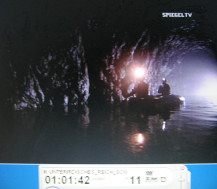
Owl Mountains 19 and 20, Juergen Mueller and Jacek Duszczak cruising in the flooded tunnels with an inflatable boat 01 and 02
[Photo: cruise with an inflatable boat].

Owl Mountains 22 and 23, Juergen Mueller und Jacek Duszczak cruising in the flooded tunnels with an inflatable boat 03 and 04
22. Owl Mountains: suspicion that there are more tunnel systems
Jacek Duszczak and Juergen Mueller are convinced that there are many more tunnel systems which are not detected yet. Because according to the few notes of the Nazis it also was projected that a huge underground production plant for the production of "wonder weapons" should be installed there. But 60 years later it's not easy to separate facts from rumors.
Jacek Duszczak, local historian (translation):
Owl Mountains 24, Jacek Duszczak is telling
"We have the information that at the end of the war all detainees have been evacuated, up to these who should camouflage the facilities. From these any track is lost, and also from these who were their guards. Of course this is unconfirmed information.
[Photo: low tunnel in bricked work supported by wooden boles]
The Nazis had very much time to camouflage the tunnels. So, it is very difficult to find the well hidden portals. They were filled up, trees are growing on them. All tracks have been destroyed."
23. Bunker constructioning in the Eulengebirge (Owl Mountains) for a new leader's headquarter: example: "Fuerstenstein Castle" ("Stone of Prince Castle")
In former times on Fürstenstein Castle ("Stone of Prince Castle") near Waldenburg [English: Forest Fortress; Polish.: Walbrzych] was residing the prince of Pless.
In 1940 the considerable possession of the Churchill family members was put under forced administration. Four years later considerable reconstruction works began. The baroque jewel - as it was said - should be transformed into a guest house of the Reich's government. In real it was foreseen for Adolf Hitler and his entourage.
So, 35 architects from the "Speer building staff" were working under most severe secrecy for an underground bunker system with direct connection to the castle.
[Photos: castle, pompous interior view]When danger was coming an elevator should bring the leader ("Führer") 50m deep to private rooms into the hill. 3200m2 floor space were projected alone for the dictator and his first entourage.
[Photo: tunnel, partly in bricked work, partly with casing].
Juergen Müller, association "Berlin Underground Worlds":
"The basic idea was among others that this should be the last leader's headquarter. So, underground tunnel systems were installed here for each of the leading personalities of the Third Reich. For example Goebbels should have it's own tunnel system. For Himmler should be an own tunnel system. Of course also the supreme command of the Wehrmacht - well - should move in here: with Keitel, with Jodl. So, there were - well - precise - well - partition plans who will get - well - m3 [?]."
24. The German population does not know anything about the tunnel systems - is living in ruins
Speaker:
At the home front these activities were absolutely unknown. xxxxxxxxxxxxxxxxxxxxxxxxxxxxxxxxxxxxxxxxxxxxxxxxxxxxxxxxxxxxxxxxxxxxxxxxxxxxxxxxxx[Photo: street bombed out].
Home front of Berlin 01: groups of people in a streetThe people's community hardly saw the leader.
[Photo: bombed street with burnt tramway].
Home front of Berlin 02: burnt tramway after an allied bomb attack
Almost every day and night the humans fled to their bunkers from the bomb attacks.
Home front of Berlin 03: road in ruins after an allied bomb attack
Because the towns were systematically razed to the ground.
[Photo: rubble women]
[The Zionist allies with Zionist Roosevelt and the Committee of 300 in London were prolonging the war deliberately for ruining all German towns to the ground. Patton and Montgomery could have occupied Germany until the end of 1943 already but the Zionist leadership did not allow an early peace. Bombing German towns to the ground also all Jewish houses were destroyed which could have given back to the Jews after the war. Zionists wanted to destroy any German culture bringing Germany back to Stone Age, and Zionists also wanted to destroy any root of Jewish life in Germany driving all German Jews to Palestine for a "Great Israel". The executive of all this was mass murderer Eisenhower].
Home front of Berlin 04: Women are forming a bucket chain to remove the rubble (rubble women)For the propaganda camera Joseph Goebbels - the head of the district of Berlin (gauleiter) - was demonstrating confidence presenting himself in the ruins of the Berlin Hedwig's Cathedral.
[Photo: Goebbels with entourage in ruins]
Home front of Berlin 05: Hedwig's Cathedral in ruins, interior view
Home front of Berlin 06: Goebbels in the ruins of the Hedwig's Cathedral
[Photo: crossing in Berlin taken from a house being converted into a fortress].25. "Axes of coordinates" and motorway tunnel in Berlin - use of the bunker as a fabrication hall
[Photo: a shaft cover is opened].Since years nobody has been down there. Dietmar Arnold from the "Association Berliner Unterwelten" ("Berlin Underground Worlds") is daring the dangerous descent, because there could be toxic gases there.
[Photo: descent on a ladder with helmet and pocket lamp].
Road tunnel system of Berlin 02, descent 01
Road tunnel system of Berlin 03, descent 02Dietmar Arnold:
Road tunnel system of Berlin 04, Dietmar Arnold in the road tunnel
Speaker:
According to the so called leader's program since october 1940 air defense bunkers in all bigger towns were installed for the population.
[Photo: population walking through ruins aside a bombed street]
They should enforce the will of resistance. And despite the looming defeat most of the Germans in 1944 were loyal to their leader (Führer).
[Photo: posters on ruins of houses:
-- "Unsere Mauern brachen - unsere Herzen nicht" ("Our walls fell - our hearts not")
-- "Die Kriegsstadt Berlin grüsst den Führer!" ("The war town of Berlin is saluting the leader!"
-- "Führer befiehl - wir folgen!" ("Leader give order - we follow!")
-- "Unsere Mauern brachen, aber unsere Herzen nicht." ("Our walls fell, but our hearts not").
26. Bunker town under Dortmund
Speaker:
In Dortmund there seems to be the biggest underground air protection system of the Third Reich which is stayed intact until now. The accesses are camouflaged because for the unwanted guests it would be much too dangerous. From time to time a team of the building authority is controlling the facility.
Bunker system of Dortmund 01, stairs
Bunker system of Dortmund 02, passing a corridor with casing
Ulrich Reckinger, state's building authority Dortmund:
Bunker system of Dortmund 07, Ulrich Reckinger is telling:
Question from unknown side:
"And when was this given up here?"Ulrich Reckinger:
Bunker system of Dortmund 09, Ulrich Reckinger is telling:
Speaker:
A public use is not foreseen. The state's authorities are providing that the tunnels are not collapsing.
27. Kaiseroda / Merkers (Thuringia): loot was placed in the bunker systems - the secret evacuation by the allies
Film: Universal Newsreel: Title: "German Loot Discovered"; by Ed Herlihy.
Salt mine of Kaiseroda 01: film cover "German Loot discovered"
Salt mine of Kaiseroda 02: film, view of Kaiseroda (or Merkers?) in Thuringia
Speaker:
The tunnels of the former potash salt mine of Kaiseroda are going far passing wide areas of South Thuringia. In the course of the decades the miners have digged 100s of km of tunnels in several floors into the salty earth. The far branched tunnel system is similar to a labyrinth. People wanting to keep something secret here hardly has to be afraid that it will detected.
[Photo: a driver is driving with an off-road vehicle in the salt mine tunnels passing salt mountains].
After the end of East Germany (GDR) the salt business is hardly running yet,
xxxxxxxxxxxxxxxxxxxxxxxxxxxxxxxxxxxxxxxxxxxxxxxxxxxxxxxxxxxxxxxxxxxxxxxxxxxxxxxxxxxxxx
[Photo: a big, yellow shovel excavator shoveling salt]
because the owners are expecting more profit from tourism. The history of the sensational gold discovery in 1945 shall stimulate the fantasy of the visitors. Perhaps there is hidden something here yet. The history of the sensational hiding was reconstructed without any doubt.
Hartmut Ruck, mine driver from K+S Merkers:

Salt mine of Kaiseroda 15 and 16, Hartmut Ruck is telling 01 and 02
Speaker:
Financial experts and art experts of the Americans began at once to evaluate the treasures. Rapidly it came out that these were the gold and foreign currency reserves of the Third Reich, and the stock of the museums of Berlin.
[Photo: gold bars are taken out of transport bags]
Salt mine of Kaiseroda 19, film, money bunches 01
Salt mine of Kaiseroda 20, film, money bunches 02
The part of stolen cultural goods was not high in this case.
Later in the mines of Southern Germany and in Austria were found many robbed pieces of art being robbed by the Nazis. Some precious pieces are said to be lost until today.
[Photo: bank notes in packages]
Salt mine of Kaiseroda 21, film, a money bag of the Reichsbank
Salt mine of Kaiseroda 22, film, an Ami soldier is counting banknotes28. Bunker plant Stuttgart: Killesberg
Step by step the allied armies were invading whole Nazi Germany. On 22 April 1945 the American and French units conquered Stuttgart.
[Photo: military vehicles in a street with trolley wire]
Stuttgart-Killesberg 01, invasion of the Amis 01
Stuttgart-Killesberg 02, invasion of the Amis 02The rest of the German troop units were not defending the town any more but capitulated in front of the superiority.
[Photo: a German soldier sitting quiet in a tank].as it seems the Wehrmacht leadership of Stuttgart was coordinating the last fight without sense. Intelligence advisors and radio assistants were given orders which only reached a few soldiers.
[Photo: writings on the wall: "Befehlsraum Verbindungsführer" ("order room connection leader"), "Kommandostab Lotsendienst Nachrichtendienst" ("staff of command - pilot service - intelligence service"), red arrow]The halls give the impression of being untouched as if there had ended the war only yesterday.
[Photo: tunnel with concrete casing, text on the wall: "In diesem Raum muss Ruhe und Ordnung herrschen" ("In this room has to be calm and order")].As it seems the bank safe was opened by force.
[Photos: a big opening with four lock devices; text on the oxidized door: "Lotsenfunkstelle. Eintritt verboten" ("Pilot mobile station. Entry forbidden")].
Stuttgart-Killesberg 10, place of the bank safe
Stuttgart-Killesberg 11, oxidized shield "Lotsenfunkstelle. Eintritt verboten" ("Pilot mobile station. Entry forbidden")
The rests of a gas mask lying on the floor.
xxxxxxxxxxxxxxxxxxxxxxxxxxxxxxxxxxxxxxxxxxxxxxxxxxxxxxxxxxxxxxxxxxxxxxxxxxxxxxxxx
[Photo: oxidizing gas mask without glasses].The door to the office of the safety police is screened by shots. Was here a last gunfight with the myrmidons of the regime?
[Photo: oxidized door with holes, bullet holes and wall damages at the door behind].
Stuttgart-Killesberg 13, door
Stuttgart-Killesberg 14, holes in the doorSomebody wanted to give his life for the leader (Fuehrer) although all was lost already?
29. Bunker system at Obersalzberg: "Berghof": almost 6 km of bunker system completed
Speaker:
For a long time the allies feared that Hitler had entrenched himself with his last contingent on Mount Upper Salt (Obersalzberg) where the Nazi leadership was maintaining a hermetic sealed refuge since the 1930s.
[The peasants families on Mount Obersalzberg were expropriated step by step being deported partly against massive resistance].
[Air photos and idyllic fotos of the region of the Obersalzberg].
Obersalzberg-Berghof 02, houses 01
Obersalzberg-Berghof 03, pit
Obersalzberg-Berghof 04, houses 02The dictator came to Berchtesgaden from again and again, also during the wars, always with his entourage, and when the leader (Führer) lingered here in the heights he was guarded by hundreds of his security forces and by the SS.
[Photo: Hitler with entourage in the buildings of Mount Obersalzberg, guards with Hitler salute]
Obersalzberg-Berghof 05, Hitler on a stairs
Obersalzberg-Berghof 06, Hitler walking up the stairs
Obersalzberg-Berghof 07, government building
Obersalzberg-Berghof 08, government building, air foto
Obersalzberg-Berghof 09, government building, portal
[Photo: people are roping down passing the shaft, the wooden stairs is only existing in parts].
Obersalzberg-Berghof 11, roping down a shaft 02
Obersalzberg-Berghof 12, roping down a shaft 03The team and the equipment are carefully let down by a complicated electric elevator rope. On the ground of the shaft the experts think that there could be an entrance to a half complete bunker facility of the SS.
[Photo: roping down passing the shaft].
Obersalzberg-Berghof 13, looking down the shaft xxxxxxxxxxxxxxxxxxxxxxxxxxxxxxxxxxxxxxxxxxxxxxxxxxxxxxxxxxxx
Obersalzberg-Berghof 14, sight up the shaft with the remnants of the wooden stairsThe men find 350 meters of unfinished tunnel corridors. First caverns had been cased with bricks already, the cable shafts are partly concreted. The drift is ending 60m deep in the rock.
[Photos of the tunnel in raw state, with bricked vaults, cable shafts].
Obersalzberg-Berghof 15, tunnel with rubble
Obersalzberg-Berghof 16, marching on a tunnel boardFlorian Beierl is one of the best experts concerning Mount Obersalzberg. Since his youth he is researching it's history asking many witnesses. Beierl knows that the inner of the brown hill looks like a rabbit burrow. The tunnel and bunker system is almost 6 km long. And even bigger facilities seemed having been in project.
There was worked feverishly in a three shift system until a short time before the end of the war. The drills of the miners were regrinded around the clock to stand out the pressure of time. There were so many workers employed that they were hindering each other. And who was chickening out of Sunday work this had the consequence of a threat of the site manager being threatened with the safety service.
Florian Beierl, expert of Mount Obersalzberg:
"Basically this is the last part of Mount Obersalzberg bunker systems which is not documented nor measured yet. It's an SS bunker being installed in an enormous depth - widely under the existing tunnel systems - and because of this, because of the long shaft which was built down here, it was not accessible.
[Photo: measuring works, plan with the text: "SS-Bunker (unerforscht)" ("SS bunker (not researched)")].
Obersalzberg-Berghof 17, measuring of a tunnel 01
Obersalzberg-Berghof 18, measuring of a tunnel 02By the digital precise measuring it's the first time that the complete picture of the whole underground Obersalzberg is drawn.
[Photo: plan, electronically in a laptop]
Obersalzberg-Berghof 19, plan 01
Studying the last documents of the Mount Obersalzberg administration concerning the tunnel systems, and considering the testimonies about this - eh - there comes the conclusion that this whole bunker area here was planned for about 400 men SS as a protection tunnel. At the same time in these huge halls which we have detected today, there had been installed relatively big ammunition deposits for the defense of this so called Alps fortification."
[Photo: tunnels with the withdrawing engineers, the tunnel is about 4-5 m high].
Speaker:
Add to this the measuring gave the result that the bunker system of Hitler's Berghof begins in a distance of hardly 10m. Should the SS being employed to defend the leader (Fuehrer) also underground?
Florian Beierl, Mount Obersalzberg expert:
Obersalzberg-Berghof 22, Florian Beierl, an expert for Mount Obersalzberg, is telling:
[Photo: Bormann's children]
Obersalzberg-Berghof 25, the Bormann children 01
Obersalzberg-Berghof 26, the Bormann children 02
Florian Beierl, Obersalzberg expert:
"The whole bunker complex of Mount Obersalzberg was autarchik and self-supporting, and really absolutely autarchik, concerning the supply: there were own water deposits, there was a poison gas proof air condition, there were food deposits, and it had been possible to stay here for a longer time. The problem had been only this: it had not been possible to protect the entrances from outside but only from the inner side to the outer side. There was no fortification outside. This means: During a siege the enemy could intrude up to the MG nests and one had been defended from there.
[Photos: vaulted corridor labyrinth, painted in white]
29.1. Bunker at Mount Obersalzberg: the Bormann family
Obersalzberg-Berghof 30, Florian Beierl in the bunker rooms of Bormann, the room has a light brown colour at the low level, and the switchers are on a children's heightNow in this area the Bormann family was sheltered. There were three different chambers - one can say - for the children: Bunk beds were installed here. The chambers were air conditioned. The interesting thing is for example that here was consciously elected a warm colour for the wall painting,
[Photo: room, in the lower part painted in beige, in the upper part painted in white]
so this existence underground - eh - should not be in a too destructive way. Eh - the light switchs were installed for the children consciously lower. So the level of the light switchs is almost 50 cm lower than normal.
[Photo: deeply installed light switch hole].
There were wooden floors. One has to imagine this: here were standing the bunk beds. And as you see: here were even pictures installed here. One can see the nails yet.
[Maybe there were hanging also other things like a jumping jack and so on].
The Bormann family was living in this bunker area for weeks, of course not only down here. They were in the house and here. But the war situation, let's say, the danger at Mount Obersalzberg by hostile bombers increased extremely since the end of '43. So, the Bormann family has really arranged itself here."
[Photos: corridors, rooms, walls torn down, tiled walls with white tiles]
Obersalzberg-Berghof 31, Bormann's bunker, corridors and rooms
Obersalzberg-Berghof 32, Bormann's bunker, tiled corner
Speaker:
Bormann's bank safe was taken out by the Americans at the end of the war. The frame can be recognized yet.xxxxxxxxxxxxxxxxxxxxxxxxxxxxxxxxxxxxxxxxxxxxxxxxxxxxxxxxxxxxxxxxxxxxxxxxxxxxxxxxxxxxx
[Photo: White wall with grey rectangle and a brick basement before].There was an intelligence center with the latest facilities to get the latest radio messages and news from the fronts.
[Photo: old radio facilities, text: "Endstufe 20, Endstufe 10, Endstufe, Empfänger, ...lautspre...", ("power 20, power 10, receiver, ...loudspe..."), partly oxidized, "Netzspannung", "Netz" ("line voltage", "net")]29.2. Bunker at Mount Obersalzberg: the bunker of Eva Braun
[Photo: meeting of Hitler and Eva Brown and others upright]29.3. Bunker at Mount Obersalzberg: preparation for Hitler's last fight
In the beginning of April 1945 stocks were brought into the bunker. Also the allied secret services believed that the dictator would be on Mount Obersalzberg already.
US newsreel:
"The supposed security of Berchtesgaden
[Air foto: with mountains]
Obersalzberg-Berghof 38, US film, bomber squadron flying to Obersalzberg-Berghof
Obersalzberg-Berghof 39, US bomber
[Photo: launch of bombs]The SS barracks nearby also received accurate attention."
[Air foto: barracks in a rectangle order; photos of explosions, accentuated with string music].
Obersalzberg-Berghof 41, US film, explosion
Obersalzberg-Berghof 42, US film, SS barracks bombed
Speaker:
The bombs destroyed most of the buildings. The Berghof was uninhabitable. The sad rest of Hitler's royal household survived in the bunkers. Then the Americans came .xxxxxxxxxxxxxxxxxxxxxxxxxxxxxxxxxxxxxxxxxxxxxxxxxxxxxxxxxxxx
US commander Omar Bradley going sightseeing on Mount Obersalzberg.
[Photo: Omar Bradley coming with two assists in lockstep]
Obersalzberg-Berghof 44, US film, Ami invasion 01
Obersalzberg-Berghof 45, US film, Ami invasion 02, Omar Bradley 01
Obersalzberg-Berghof 46, US film, Ami invasion 03, Omar Bradley 02The destroyed Berghof became an attraction for the winners.
[Photos: white shield fixed on beams, text: "HITLER'S HOME"; soldiers enjoying the view and a guard keeping watch].Also the mysterious bunker facilities are a part of the soldier's sightseeing program. Curiously a GI of the US army is entering the leader's bunker for the camera.
[Photo: soldier in a vaulted corridor]
Obersalzberg-Berghof 50, US film, Amis are on sightseeing tour for the bunker 01
Obersalzberg-Berghof 50, US film, Amis are on sightseeing tour for the bunker 02On 1800m2 Hitler and his last entourage had been able to endure here for weeks.
[Photos: rooms without windows, painted in white, with wooden door frames].
Obersalzberg-Berghof 52, bunker entrance with a red arrow 01
Obersalzberg-Berghof 53, bunker entrance with a red arrow 02Florian Beierl, expert of Mount Obersalzberg:
Obersalzberg-Berghof 54, bunker entrance, Florian Beierl is telling:
When on May 1, 1945, the radio announced Hitler's death above all security agents were plundering the staying remnants of their boss. Later there were local civilians of Berchtesgaden who could serve themselves of the heaps of stocks with the permission of the Americans.
[Photo: a soldier is marching through the corridors and passing a book shelf].
Hitler's private archive had been burnt from one of his adjutants in time yet. The staying library in the bunker, the discs and the paintings were confiscated by the Americans.
[Colored photos: vaults without windows, painted in white, wooden floor, little stone heaps and pieces of wood on the floor; old pictures in black and white: many paintings in the deposit with GI; the same GI in another room with a disc].29.4. Bunker at Mount Obersalzberg: Eva Braun's rooms
[Photo: room with furniture in pieces, a GI]In April 1945 the caverns were ready for occupancy, filled with the considerable wardrobe and with porcelain.
[Photo: room with a floor lamp on the floor, with books on the floor, a GI, a champagne bottle and a champagne glass on a chest of drawers, the GI is "testing" the double bed, wardrobe and porcelain are not shown].
The rooms are empty as they were swept. But despite of this again and again criminal treasure hunters are breaking into the facility for searching the mysterious labyrinth.
Right aside Eva Braun's cavern was the one of the leader (Fuehrer). It's said to be arranged in a spartanic way. The furniture was removed by the Americans. The rest was falling into tourists hands. Even the tiles of the bathroom [of Eva Braun's bathroom] were taken as doubtable souvenirs.
[Photo: vaulted room without tiles].
Hitler himself had been here only one single time. He decided himself for the downfall in Berlin.
^

